
MAGAZINE NOVEMBER & DECEMBER 2022 PLAYHOUSE SQUARE Century-Old Cleveland Theatres Still Dazzle Page 24 DISTINGUISHED SERVICE An Ohio Yorkie Who Served in World War II Page 42 WHAT’S YOUR STORY? Our Readers’ Favorite Thanksgiving Recipes Page 4 75 YEARS AGO Television Goes on the Air in Ohio Page 34
Cover: Guests mingle in the restored lobby of Cleveland's 1921 Ohio Theatre, one of five century-old movie, vaudeville and legitimate theatres gracing the city’s Playhouse Square district. See page 24.
Photo by Kevin G. Reeves, courtesy of DLR Group
Vol. 61, No. 6
EDITORS
Bill Eichenberger
Tom Wolf
CONTRIBUTORS
Jerri Donohue
Tim Feran Martha Pallante Marci Rich Malachy Sullivan
ADVISORY
Donna DeBlasio
Youngstown State University
Nishani Frazier Miami University Robert Genheimer Cincinnati Museum Center
Stephen George Ohio History Connection
Alex Hastie Ohio v. the World George Ironstrack Miami University Chester Pach Ohio University
Roger Pickenpaugh Historian and Author
Daniel Rivers
The Ohio State University Truda Shinker Ohio History Connection
Echoes Magazine (ISSN 0012-933X ) is published bimonthly and distributed by the Ohio
as

Editorial Offices: Ohio History
Ohio History
17th
43211-2474
Phone 844.836.0012
Email echoes@ohiohistory.

Postmaster:
Echoes Magazine,
Entire
At 101, Cleveland’s Playhouse Square Still Dazzles Sign-On Pioneer—WEWS, Ohio’s First TV Station
From a Foxhole in the Pacific to Television Celebrity—Smoky’s Incredible Journey
Our Readers’ Favorite Thanksgiving
IN EACH
Contents
From Our Editors What’s Your Story? In the News From Our Director Historic Sites & Museums
At the Ohio History Center & Ohio Village
Events
Events
Exhibits
Wish I’d Been There
Eyes on the
History
2 Echoes | NOVEMBER & DECEMBER 2022 Contents NOVEMBER & DECEMBER 2022
Recipes
ISSUE
Online
Featured
&
I
Young
Past Reviews
BOARD
History Connection
a benefit of Ohio History Connection membership.
Connection,
Center, 800 E.
Ave., Columbus, OH
org
Please send address changes to:
Ohio
Connection, Ohio History Center, 800 E. 17th Ave., Columbus, OH 43211-2474
contents © 2022 by the Ohio History Connection. All rights reserved. Nothing may be reprinted or electronically reproduced in whole or in part without written permission from the publisher. The Ohio History Connection accepts no responsibility for facts and opinions expressed by the authors. MAGAZINE 24 34 42 4 2 4 4 6 7 15 16 19 20 46 48 50 Moving? Contact us at membership@ohiohistory.org or 800.686.1545 to share your new address. THANKS TO OUR OHIO HISTORY CONNECTION STRATEGIC PARTNERS: Like us on Facebook, and follow us on Instagram, Twitter and TikTok at @OhioHistory The Ohio History Connection is a
Historic Preservation
AT 101, CLEVELAND’S PLAYHOUSE SQUARE STILL DAZZLES

Four spectacular theatres—the State, Ohio, Hanna and Allen— opened at Cleveland’s Playhouse Square in 1921, followed by another in 1922, the Palace. Then our nation’s fifth-largest city, Cleveland was booming. Its theatre district enhanced local cultural life until the 1960s, when hard times hit for downtown theatres and four of them closed. Thanks to forward-looking northeast Ohioans who rallied to save them, Cleveland’s now century-old Playhouse Square theatres still dazzle.
Sign-On Pioneer
WEWS, OHIO’S FIRST TV STATION

Seventy-five years ago, on Dec. 17, 1947, Cleveland’s WEWS became the first TV station in the Buckeye State to sign on the air, soon followed by more in 1948 and 1949. Author Tim Feran looks at the early days of WEWS and the advent of television in Ohio.
From a Foxhole in the Pacific to Television Celebrity
SMOKY’S INCREDIBLE JOURNEY
During World War II, a tiny pet Yorkshire terrier owned by an Ohio GI helped lay crucial telephone and telegraph cables, and later served as a therapy dog for sick and wounded GIs. That recently earned her posthumous selection as one of the first dogs to receive the Animals in War & Peace Distinguished Service Medal. Author Jerri Donohue shares the story of Smoky.
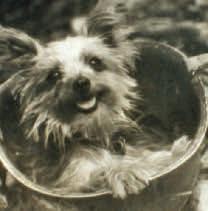
Your Story?
OUR READERS’ FAVORITE THANKSGIVING RECIPES
our September & October 2022 issue, we invited readers to share a favorite Thanksgiving recipe. Just in time for menu planning, we share their responses on pages 4 and 5. Echoes Magazine doesn’t have a test kitchen, though they sure sound good!
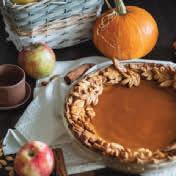
OHIOHISTORY.ORG 3 24
42 What’s
In
4 34
FROM OUR EDITORS
On Nov. 6, 1922, Cleveland’s Palace Theatre opened as the Keith vaudeville chain’s flagship, featuring Columbus native Elsie Janis—two decades a performer on the circuit—as the headliner. It was the fifth of five spectacular new theatres opened at Playhouse Square in 1921 and 1922 (see page 24), and local newspapers were duly impressed.
The Palace reminded Cleveland News theatre critic Archie Bell of “the throne rooms of European monarchs.” William F. McDermott of the Plain Dealer said, “In this Cleveland playhouse we beat the world. A lavishness, a disregard of money and a care and taste have gone into it that make the theater unique among show places.”
Smoky the Yorkshire terrier didn’t come up to the top of Bill Wynne’s army boots. But her size didn’t stop Smoky from assisting Wynne and the Fifth Air Force’s 26th Photographic Reconnaissance Squadron in building an airstrip for U.S. planes during World War II. (See page 42.)
Which got us to thinking about other furry or feathered fighters down through history. One pigeon, Cher Ami, earned the French Croix de Guerre for delivering 12 messages between forts in northern France, despite having been shot and wounded by German forces. Wojtek, a bear cub adopted by Polish soldiers during World War II, helped carry crates of ammunition and rose to the rank of corporal in the Polish army.
When WEWS went on the air on Dec. 17, 1947, the television station figures more people saw Jimmy Stewart live in the studio (one of the largest in the country) than on a TV set. At nearly $400, TVs were out of reach for most families. It’s estimated that there were only 300 sets in all of Cleveland in 1947.
But what a difference a year makes. By the time 1948 was about to turn into 1949, TVs had dropped as low as $130 and 10,000 Cleveland households boasted a set. Things would never be the same. (See page 34.)
In a documentary for the 50th anniversary of WEWS, Don Webster, host of the station’s locally produced music show, Upbeat (1964–1971), recalls a Dec. 9, 1967, performance by Otis Redding the day before Redding died with most of his backing band in an airplane crash en route to a show in Wisconsin.
At its height, Upbeat aired in more than 100 cities across the country. And did you know that WEWS’s Polka Varieties was one of the longerrunning shows in television history, on the air from 1956 to 1983?
One of our grandmothers was a faithful viewer for most of that time, so we figured it had a good run. But 27 years?!
What ’s “
In every issue of Echoes Magazine, we feature the stories of Ohio History Connection members and other Ohioans to stoke memories and shed light on our shared past.
For this issue, we asked, What’s your favorite Thanksgiving recipe?”
Here are some of your responses:
Great-Aunt Leony's Great-Grandmother's
LEMON CRACKERS
4 teaspoons baking ammonia 2 cups milk, warm 2½ cups sugar 8 cups flour 4 beaten eggs 1 teaspoon lemon oil 4 teaspoons baking powder 2 cups melted lard ½ teaspoon salt
Dissolve the baking ammonia in some of the warm milk. Mix all the ingredients together, roll the dough mixture out, cut it with a cookie cutter, place it on a cookie sheet.
BAKE: 8–10 MINUTES AT 375
NOTE: One of my favorite cookies for Thanksgiving is my great-aunt Leony’s Lemon Crackers. This is the recipe handed down to her by her great-grandmother. In time, the cookies, if they last that long, will lose their moisture and become like crackers, hence the name. You may have trouble finding the baking ammonia and the lemon oil. We found it at the pharmacy. These were a favorite cookie long ago because they did not require refrigeration. They also make a great Christmas gift.
4 Echoes | NOVEMBER & DECEMBER 2022
—Doris Coy, Pickerington; Patricia Spires, Jackson
Your Story? THANKSGIVING RECIPES
Eleanor Keck's
AVOCADO GELATIN SALAD
2 packages lemon gelatin
2 tablespoons sugar
1 cup orange juice
1 ¼ cup pineapple juice
1 cup hot water
½ cup mayonnaise
¼ cup cereal cream (half-and-half)
1 mashed avocado
Grated orange rind*
*May also add grated lemon rind and/or lime rind
Dissolve gelatin and sugar in hot water. Add orange and pineapple juices and cool to jelly consistency. Combine mayonnaise, cream, mashed avocado and orange rind. Combine with gelatin mixture and pour into a 1-quart mold. Refrigerate.
YIELD: SERVES 12
NOTE: My mother, Eleanor Keck, created this salad and used it frequently at Thanksgiving and Christmas. It is at the same time sweet, tart, creamy, yet not too heavy. At other times, it can be used as dessert. This recipe won an award and $25 from the Toledo Blade and was published in the newspaper.
Aunt Lucile’s
CRANBERRY SALAD
1 cup ground raw cranberries
½ cup sugar
½ orange, ground (peel and all)
Mix the above and let stand.
Cut finely and mix with the above: ½ cup celery ½ cup walnuts or pecans
Combine all with: 1 4-ounce package of lemon or orange gelatin dissolved in 2 cups water
Refrigerate overnight.
YIELD: This recipe doubled fills a ring mold with a little bit left over. —Barbara W. Lindstrom, Howard
Our Family
APPLE BUTTER
1 60-quart copper kettle
1 copper penny
½–1 gallon apple cider
5–6 bushels of apples
5–15 pounds of sugar (depends on the sweetness of the apples)
4–6 (4-ounce) cans of cinnamon
22 ounces or 1 bag of red hot candies
YIELD: 275–300 HALF PINTS
NOTE: The Thanksgiving meal is over, the dishes washed and dried and preparations for the weekend activities are about to begin. Early Friday morning, our dad, Haldor, and grandfather, Cleve, along with a group of children and grandchildren, set out to the apple orchard to pick at least 5–6 bushels of apples (Rome Beauties preferred).
Upon returning to our grandparents’ house, our mother, Evelyn, and grandmother, Hazel, are ready to begin peeling, coring and quartering the apples.
—David Keck, Howard (Other family members and relatives often appear to assist in this process.) The apples are placed in an air-tight container in the cellar.
Our mother and grandmother then begin assembling the items needed for the next day.
Tasting is the most important part of this process, and many take part in this activity. A fire is prepared and the kettle is placed in the stand. The penny is placed in the bottom of the copper kettle and the cider added. Slowly the apples are added and the stirring begins. This continues until the apples become a sauce.
Slowly added with tasting and stirring done often—the sugar (stir-taste), cinnamon (stir-taste) and the bag of red hot candies (stir-taste). After the officials pronounce the apple butter is thick and tasty, the glass jars are filled and sealed. With this completed, our Thanksgiving weekend is over until next year.
—Doris Coy, Pickerington; Patricia Spires, Jackson
WHAT’S YOUR STORY?
We want to know your stories, so in every issue of Echoes Magazine we ask you a question, then run selected answers in the following issue. Here’s the question for January & February: Do you ever go ice fishing? On which body of water? What do you catch? What do you like about being out on the ice?
Email your story responses (50 to 150 words) by Nov. 10 to echoes@ohiohistory.org or, if you follow us on Facebook, send us a Facebook message.
OHIOHISTORY.ORG 5
In the News
OHIO VILLAGE
$1 Million Gift Endows
Ohio Village Presenters
A $1 million gift from an anonymous donor—the largest individual gift the Ohio History Connection has ever received—will establish an endowment for full-time historical presenters at Ohio Village, our recreated 19th-century community in Columbus.

“This will enable us to create amazing experiences for countless visitors for many years to come,” says Ohio History Connection Executive Director and CEO Megan Wood.
At Ohio Village, presenters— called “interpreters” in the museum world—bring history to life through their first-person portrayals of people from Ohio’s past. Ohio Village currently has 14 part-time presenters and one full-time presenter, in addition to
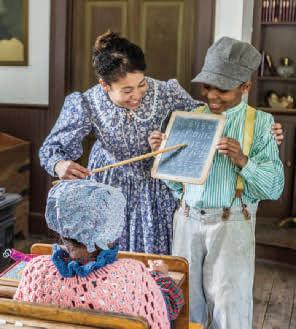
four other full-time village staff. They’re supplemented by about 35 volunteer presenters who help populate the village during its open hours and an additional 35 who take part in large-scale special events such as All Hallows’ Eve and Dickens of a Christmas.

BRINGING HISTORY TO LIFE
“We’re thrilled beyond belief to receive this gift. Bringing people, places and stories to life is an integral part of what we do at the Ohio History Connection,” says Ann Ruege, chief development officer for the Ohio History Connection. “This gift allows us to support the work of our interpreters and bring more history to life for all Ohioans. I will be forever thankful to our supporters who make this work possible.”
Located just north of the Ohio History Center at I-71 & 17th Avenue in Columbus, Ohio Village is
open seasonally. It depicts smalltown life, currently of the 1890s, a time when innovation and invention were building a bridge between the 19th century and the 20th in many Ohio communities.
In addition to the history presenters, attractions include a one-room school, general store, pharmacy, bicycle shop, toy store, print shop, bank, town hall, church, hotel, funeral parlor, blacksmith shop, Masonic lodge, women’s club and several homes. All serve as settings where presenters can share stories and experiences of the past.
SHARING MORE STORIES
In recent years, the Ohio History Connection has been actively working to broaden the variety of stories shared in Ohio Village so that they’re reflective of all Ohioans.
Jen Cassidy, director of the Ohio History Center & Ohio Village, says “We are so honored to receive such
6 Echoes | NOVEMBER & DECEMBER 2022
a generous gift in support of our hardworking interpretive staff. Our research shows what visitors value most is interacting with our staff, and this gift will help ensure that we can continue to support our presenters far into the future. We look forward to continuing to provide high-quality experiences to folks visiting Ohio Village.”
Opened in 1974, Ohio Village was carefully planned to look as though it was built over decades from the settlement of Ohio through the Civil War, though in reality it was all built at once except the tavern, school, church and John Hauck Foundation Welcome Center, each added later.
Built with children and school groups in mind, village buildings— except the church, school and Welcome Center—are a bit smaller than their real-life counterparts. None are literal reproductions of real Ohio buildings, though all are inspired by an informed awareness of Ohio’s architectural heritage, as is the layout of the village around a green or square.
Learn more about Ohio Village and plan your next visit at ohiohistory. org/village
FROM OUR DIRECTOR
One highlight of my job is the chance to see and experience more of Ohio’s art, history, natural beauty and local businesses.

As we move into cooler months, there are great opportunities for overnight trips to take in holiday programming, sledding and skiing, and activities at local and county museums and historical societies. Every season is a chance to discover local traditions.
In August, I represented the Ohio History Connection for an Ohio Historical Marker dedication with the Ohio Department of Natural Resources at Shawnee State Park’s Theodore Roosevelt Preserve in West Portsmouth, Ohio.
Not only did I “meet” President Roosevelt, I took my daughter along to enjoy the activities. Dubbed my “tiny assistant,” she held my papers and took pictures for me.
Dedicated in 1922, the Roosevelt Preserve began with 20,000 acres of land for hunting game and reforestation. Ohio’s first public shooting grounds, it was the beginning of hunters and anglers working with the state on land and game preservation. In August, ODNR commemorated this 100-year partnership with an Ohio Historical Marker.
After hanging out with Smokey Bear at the dedication, we enjoyed a hike around part of Turkey Creek Lake. We stayed overnight at an Airbnb in Portsmouth, had dinner at Patties and Pints, explored downtown and strolled the floodwall murals.
In the morning, my tiny assistant and I enjoyed breakfast at Lofts Coffee Co. Thanks to a tip from an ODNR employee, after applying for a permit, we hiked 500 feet up Raven Rock State Nature Preserve for an excellent view of the Ohio River, Portsmouth and Kentucky.
On our way home, we stopped in Chillicothe for lunch at The Pour House at Machinery Hall, a great adaptive use of a historic building. That reminded us that we need to come back to visit Adena Mansion & Gardens, Hopewell Culture National Historical Park, Junction Earthworks, Great Seal State Park and many other sites.
The trip also reminded me of the connections between our work and our state and communities. As we encourage people to visit our sites and participate in our programs, we also encourage curiosity and interest in Ohio’s places and stories.
And, in the season of giving, it reminds me of the support we can provide to Ohio businesses and nonprofits by shopping locally. As a private nonprofit, our work is made possible through gifts from members and donors like you. Consider joining me in supporting the Ohio History Connection (ohiohistory.org/give) and other nonprofits that make our state great.
OHIOHISTORY.ORG 7
We look forward to continuing to provide high-quality experiences to folks visiting Ohio Village.
Megan Wood | Executive Director & CEO, Ohio History Connection
THE NEXT 10 YEARS
Development
by Ann Ruege, Chief Development Officer
The Ohio History Connection’s development work encompasses fundraising, membership, business development, events, our cafe at the Ohio History Center, and online and in-store retail at the Ohio History Center & Ohio Village. A team of dedicated ambassadors for our organization, our development staff create opportunities to generate funds that help advance the Ohio History Connection’s mission.
We accomplish this by cultivating relationships with individuals, foundations, corporations, members and guests through philanthropy, membership, retail sales and event sales. Each member of our team shares a commitment to the power of history to create connections. After all, development is about providing avenues for connections— to our organization, through our events and exhibits, and with stories that connect us all to our past and our communities.
Our three Ohio History Connection strategic initiatives are relationship building, equity and sustainability.
DONOR RELATIONS
Making connections is about successful relationship building, which is integral to our daily work. Individuals and organizations that donate to the Ohio History Connection do so as a way to establish a relationship with our organization, with Ohio’s stories and with their own connections to Ohio history.
Some may have come to Ohio history as I did: starting at a young age with an exciting history teacher I still vividly recall, and a father who both taught history and loved visiting historic places in our state with his family. I remember traveling with my parents and siblings to
see Seven Caves, Roscoe Village, Flint Ridge Ancient Quarries & Nature Preserve and Mound City. And when I talk to donors, I’m reminded that being stewards for historic places all across Ohio also makes us stewards for the stories of family road trips that are only possible because of the work of the Ohio History Connection and our partners.
We believe in cultivating and stewarding relationships so they become meaningful and longlasting. They create transformative connections with Ohioans worldwide and advance our efforts to preserve and share Ohio history.
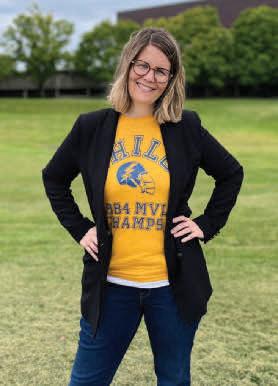
MEMBERSHIP
Our goal at the Ohio History Connection is to welcome all Ohioans. With our 50+ historic sites and museums across Ohio (see page 15), your Ohio History Connection membership means that you’re never far from learning more about our shared story as Ohioans. And while Ohio History Connection membership is already a great value, soon we’ll be piloting a new membership program where this value shines through. Our goal is to have an option for every Ohioan to become a member and enjoy all that the Ohio History Connection has to offer.
BUSINESS DEVELOPMENT
Becoming more financially and environmentally sustainable is a key to success today. How can we package the items from our gift shops and cafe more sustainably? What’s our return on investment for each event or program?
Soon you’ll see some changes at the Ohio History Center & Ohio Village that will help move us toward becoming more environmentally sustainable, such as a grant-funded project through Honda that will bring electric vehicle charging stations to our Columbus campus.
Financial sustainability is important to every organization. Current national financial pressures don’t escape us. Our leadership team’s strategic decision-making is guided by ensuring the Ohio History Connection’s financial sustainability into the future.
We have history together. It’s the role of our development team to ensure that the Ohio History Connection can continue to preserve and share the places and dynamic stories of our shared Ohio history, and we thank you for your support.
Our online user accounts now have stricter password requirements. Call 800.686.1545 or email membership@ ohiohistory.org if you have questions about yours.
8 Echoes | NOVEMBER & DECEMBER 2022
Ann Ruege is Chief Development Officer for the Ohio History Connection
Grants Totaling $720,280 Further Special Projects
Six recent grants totaling $720,280 are enabling special projects related to the Ohio History Connection’s strategic plan.
INSTITUTE OF MUSEUM AND LIBRARY SERVICES
The Institute of Museum and Library Services (IMLS) recently awarded two grants: $249,810 from its largest competitive grant program, Museums for America, for “Marking Diverse Ohio,” an effort to broaden the stories shared on Ohio Historical Markers. Conceived in 1953 during Ohio’s 150th birthday, there are now more than 1,700 brown-and-gold Ohio Historical Markers around the state. The grant will help diversify the stories shared on the markers to highlight ways all Ohioans, and all counties, have contributed to our state’s history.
A $49,340 National Leadership Grant for Museums to aid work with five partner museums in Columbus and community members to evaluate a program model for the Museums for All initiative. Museums for All is a partnership between IMLS and the Association of Children’s Museums that encourages low-income families to visit museums and build lifelong museum habits.
OHIO HISTORY SERVICE CORPS
A $221,130 grant from ServeOhio, the Ohio Commission on Service and Volunteerism, continues the Ohio History Service Corps for a 12th year. An AmeriCorps program, Ohio History Service Corps provides training to help local history organizations become more effective and sustainable and to help communities take first steps in historic preservation. The Ohio History Connection selects
10 Ohio History Service Corps members annually to work with host sites across the state. Since the program’s inception, more than 100 Ohio History Service Corps members have had a lasting impact on our state’s local history and preservation organizations and their communities.
UNDERREPRESENTED COMMUNITY HISTORY
With two consecutive $50,000 Underrepresented Community Grants from the National Park Service, the Ohio History Connection’s State Historic Preservation Office is identifying places associated with African American history in Ohio and facilitating their nomination to the National Register of Historic Places. Diamond Crowder, underrepresented communities survey and National Register manager, has prepared a nomination for Cincinnati’s King Records Company buildings, working with members of the King Records Legacy Committee. Nationally significant, King was an integrated independent record company in the 1940s and 1950s, with recording artists including James Brown. Crowder is also amending the National Register listing for Cincinnati’s Harriet Beecher Stowe House to add its history as the Edgemont Inn, a boarding house listed in the Negro Motorist Green Book of the 1930s and 1940s. Further projects will document more Green Book sites, plus places in Ohio that are associated with the 20th-century civil rights movement, and create a plan for encouraging more Ohioans to prepare National Register nominations for places associated with Black history in our state.
In partnership with the Cleveland Restoration Society, the State Historic Preservation Office is documenting the role of 20 Black churches in the city’s history. The project includes preparing National Register questionnaires for churches interested in future National Register listing and preparing a National Register nomination for the architecturally remarkable former Euclid Avenue Temple (Anshe Chesed), now Liberty Hill Baptist Church, significant in Cleveland’s Jewish and African American history.
NATIVE AMERICAN GRAVES PROTECTION AND REPATRIATION ACT WORK
A $100,000 National Park Service grant is aiding work to repatriate ancestral remains and cultural items from Ohio History Connection collections as part of the Native American Graves Protection and Repatriation Act. The grant is funding consultation with tribal members and research to support the repatriation process and ensure the preservation of Indigenous culture. In its collections, the Ohio History Connection has about 7,000 American Indian ancestral remains and more than 100,000 funerary objects. This project focuses on collections from nine northwestern Ohio counties: Defiance, Fulton, Hancock, Henry, Lucas, Paulding, Putnam, Williams and Wood.
Keep your holiday shopping simple:
new gift memberships Nov. 1 through Dec. 3. See our ad on page 19.
OHIOHISTORY.ORG 9 GRANTS NEWS
Save 20% on
Give the Gift of
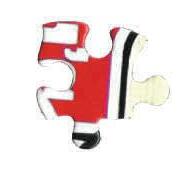
Children’s Holiday Books Collection Are you ready for Santa to visit your home? Celebrate the holidays with this collection of three children’s books all about Santa visiting the Buckeye State. Along the way, you’ll spot familiar Ohio highlights, including the Rock & Roll Hall of Fame, LeVeque Tower and many more. I Saw Santa in Ohio $12.99 X Santa is Coming to Ohio $12.99 X ‘ Twas the Night Before Christmas in Ohio $11.99 X
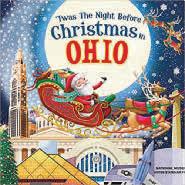
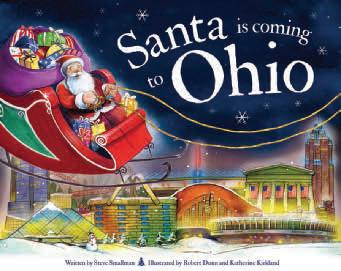
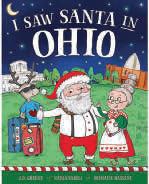
I Love Ohio Puzzle Showcase your love of Ohio with this 1,000-piece jigsaw puzzle. Features staples of the Buckeye State in a collage design that once completed measures 24”x 30.” $19.99
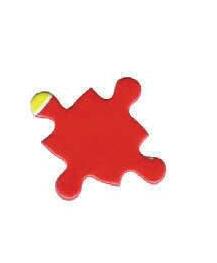
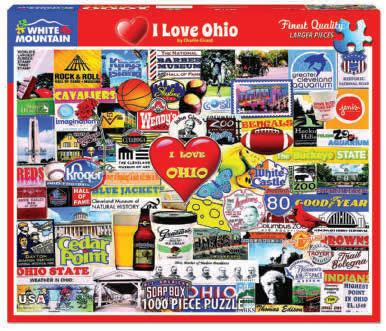
Ohio Bike T-Shirt
This Ohio Bicycle T-shirt makes the perfect gift! Triblend heather navy T-shirt featuring a handdrawn Ohio bike image comes in both unisex and women’s cuts, with sizes of S, M, L, XL and XXL. $26.99 X
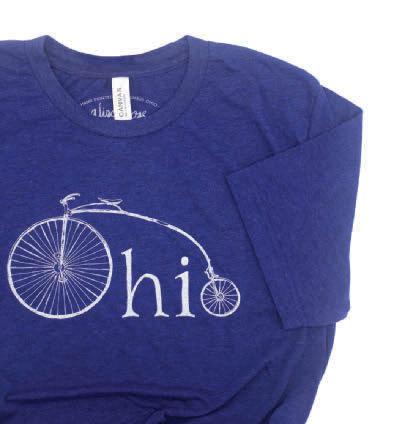
X X
Ohio
with These Holiday Hits!
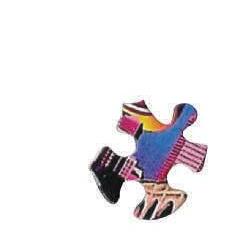
Women’s Suffrage Collection Celebrate women’s history with this art print and recipe book used during the suffrage movement. The cookbook features a collection of recipes and miscellaneous tips published to raise money for the women’s suffrage movement. The 11” x 17” print showcases an image created in 1915 and used as a tool to spread the suffrage message. Let Ohio Women Vote Print $8.99 X The Woman Suffrage Cookbook $14.95 X
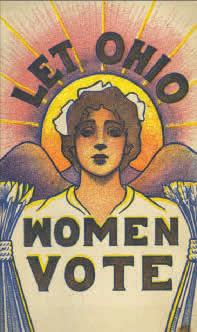

Etch A Sketch Give this classic children’s toy that originated in Ohio! Released in 1960 in Bryan, Ohio, by the Ohio Art Co., Etch A Sketch has been a staple of children’s lives ever since. Original Etch A Sketch (7.5” x 9”) $23.50 X Pocket Etch A Sketch (3” x 3.75”) $9.99 X
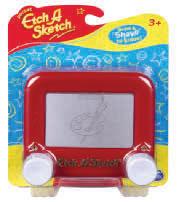
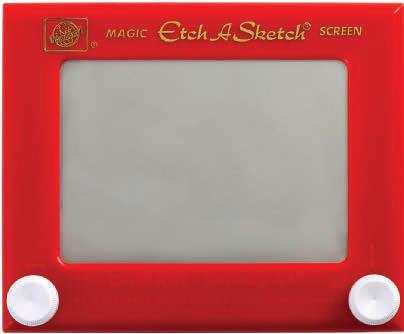
Ohio Christmas Cards
Send your loved ones a piece of Ohio with these Ohio Christmas cards. These creative cards feature Ohio staples in the format of the popular song The Twelve Days of Christmas. Each boxed set includes 10 cards and envelopes. $16.99 X
Ohio History Store Shop in person at the Ohio History Center or online at ohiohistorystore.com for these and other merry gifts! X Ohio History Connection members enjoy a 10% discount with coupon code MEMB1803 Online orders add 7.5% sales tax plus shipping and handling. Questions? Call 833.352.1208.

OHIOHISTORY.ORG 11
X X X
HISTORIC PRESERVATION
Recent Ohio Additions to the National Register of Historic Places
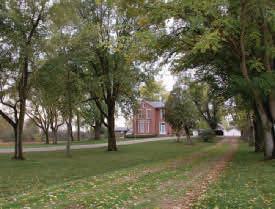

BEREA • CUYAHOGA COUNTY BALDWIN WALLACE COLLEGE SOUTH CAMPUS HISTORIC DISTRICT (BOUNDARY INCREASE)
84, 114, 115, 125, 144 Tressel, 191 E. Center St. and 275 Eastland Rd.
The Baldwin Wallace College South Campus Historic District listed in the National Register in 2010 has added six buildings representing the school’s growth during the 1960s and 1970s, when enrollment grew due to the post-World War II baby boom. They comprise Ernsthausen Hall (1961), Heritage Hall (1963), Strosacker Hall (1965), Constitution Hall (1966), Bonds Hall (1969) and
Kamm Hall (1976). Architects Heine, Crider and Williamson of Berea designed all six in the Georgian Revival style that Baldwin Wallace had adopted for campus buildings starting in 1929.
CINCINNATI • HAMILTON COUNTY
UNITED COLORED AMERICAN CEMETERY 4732-4734 Duck Creek Rd. (at corner of 4805 Duck Creek Rd.)
Founded in 1883, this cemetery is associated with African American history in the Queen City and the broad historic pattern of racial segregation, even in death. Wendell Dabney, in his 1926 book, Cincinnati’s Colored Citizens, described Cincinnati’s two Black cemeteries—the United Colored American Cemetery and Union Baptist Cemetery—as “Our Greatest Enterprise.” The resting place of Underground Railroad leaders as well as writers, politicians, businesspeople, artists, civil rights leaders and many military veterans— including at least 55 African American veterans of the Civil War— the cemetery has an important collection of gravestones with symbolic and folk-art carvings. Its plan reflects the 19th-century rural cemetery movement, with graceful, curving roads, open meadows of irregular outline and picturesque placement of monuments. Prominent landscape architect Adolph Strauch (1822–1883), who designed several Cincinnati parks as well as the Queen City’s noted Spring Grove Cemetery, planned it.
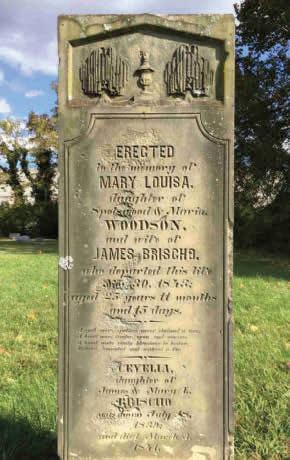
CIRCLEVILLE VICINITY • PICKAWAY COUNTY
FLEMING-HOFFMAN FARM 25043 OH 104
Still an active farmstead, the Fleming-Hoffman Farm is historically associated with farming in Wayne Township. From 1836 to 1933, three generations of the Fleming family owned the property, and from 1948 to the present, three generations of the Hoffman family have done the same. The FlemingHoffman Farm is also significant as an example of mid-19th-century rural vernacular architecture with Italianate-style features typical of the 1870s and 1880s.
CLEVELAND • CUYAHOGA COUNTY
NATHANIEL HAWTHORNE ELEMENTARY SCHOOL 3575 W. 130th St.
Locally significant for its association with the history of education, Nathaniel Hawthorne Elementary School is an example of progressive school design associated with Cleveland’s tremendous growth in the early 20th century. Built as Jefferson Park School in 1917 by West Park Township, it was enlarged in 1920 and again in 1927 after West Park was annexed into the city of Cleveland.

CLEVELAND • CUYAHOGA COUNTY
AUDUBON SCHOOL
3055 Martin Luther King Jr. Dr.
Built in 1922, Audubon School is significant as an example of an early-20th-century fireproof public school in the Englishinspired Jacobethan style of the time. The design is the work of Walter McCornack, architect for the
12 Echoes | NOVEMBER & DECEMBER 2022
Cleveland Board of Education from 1914 to 1925. Its floor plan is known as the E-plan. It’s the only remaining junior high school and one of three remaining Jacobethan-style buildings that McCornack designed for Cleveland City Schools.
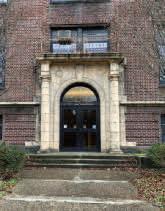
CLEVELAND • CUYAHOGA COUNTY
McKINLEY SCHOOL
3349 W. 125th St.
The 1921 McKinley School is locally significant in the area of architecture. This fireproof elementary school building is the work of Cleveland architects Fulton, Taylor and Cahill, who designed it in the then-popular Jacobethan style for the city of West Park Board of Education. Its floor plan is known as the T-plan. The English-inspired Jacobethan style dominated the school designs of Fulton, Taylor and Cahill in the early 20th century. McKinley School was named a city of Cleveland landmark in 2010.
DAYTON • MONTGOMERY COUNTY
DAYTON VIEW TRIANGLE
HISTORIC DISTRICT
Bounded by Salem Avenue, Cornell and Philadelphia Drives

The Dayton View Triangle Historic District is associated with the history of planning and
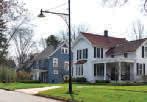
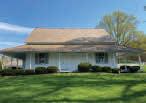


development in the Gem City from 1904 to 1976, and with events related to local social history, particularly civil rights in housing and transformation of a oncesegregated neighborhood into a racially diverse one by the mid1970s. The period of significance begins with the platting of the earliest subdivision, Mt. Auburn, in 1904, and ends with formation of the Dayton View Triangle Federation of Homeowners in 1976. Dwellings in the district range from historical revival styles popular in the early decades of the 20th century to mid-20th century modernism.
HANOVERTON • COLUMBIANA COUNTY
NEW GARDEN MONTHLY MEETINGHOUSES 32114 Winona Rd.
This property encompassing two Friends or Quaker meetinghouses is significant for the influence that the New Garden Monthly Meeting and its members had on the area’s educational and agricultural achievements and social mores. The 1838 and 1895 meetinghouses are examples of Quaker Plain Style architecture of two different eras and plans: the Quaker Ideal Plan and the Chesterfield Plan, both typical for the time of their construction.
HUDSON • SUMMIT COUNTY HUDSON HISTORIC DISTRICT (BOUNDARY INCREASE II)
Roslyn Avenue, Elm, Aurora, Baldwin, Chapel, Church, Division, Hudson, North Main, North Oviatt, Owen, Brown and West Prospect Streets
The end of the period of significance of the Hudson Historic District has been extended from 1940 to 1963, and the boundaries of the district have been expanded to take in the Chamberlin Subdivision, including Elm Street and extending along Roslyn Avenue. Buildings in the added area are predominantly oneand two-story post-World War II homes in the Colonial Revival, Cape Cod and Minimal Traditional styles. Two historic streetlights with fluted shades remain on the Elm Street tree lawn in front of 118 Elm Street and 165 Elm Street. The district was added to the National Register in 1973, and its boundary has been extended once before, in 1989.

NORTH CANTON • STARK COUNTY PORTAGE STREET ELEMENTARY SCHOOL 239 and 301 Portage St.
Associated with the history of education in North Canton for more than a century, this centrally located school building has served the educational needs of local children as the community has grown and developed, largely due to the success of the Hoover Company, headquartered in North Canton for many years. It’s always been in use for some form of education, and thousands of children have passed through its doors. From 1920 to 1956, it was North Canton’s only elementary school and it continued in use as an elementary school until 1982. Subsequently a Montessori school, today it’s a pre-school/early childhood development center.
OHIOHISTORY.ORG 13 All National Register photos courtesy State Historic Preservation Office
OHIO STORIES
Powel Crosley Jr.
Powel Crosley Jr. was born on Sept. 18, 1886, in Cincinnati. He attended local schools and then enrolled in the Ohio Military Institute in 1901, receiving a degree in 1905. Crosley proceeded to enroll in the University of Cincinnati, pursuing an engineering degree, but the next year, he transferred to UC’s law school.
Upon leaving the University of Cincinnati, Crosley began his own automobile manufacturing business. His firm quickly failed, as it lacked the necessary capital. Crosley went on to work several jobs; most were selling products by mail order. In 1916, he purchased an automobile parts mailorder business, and over the next two years, Crosley sold more than $1 million in parts. He liked to boast that he never earned more than $50 a week until he was over 30 years of age. This may very well have been true, but with the purchase of the automobile parts company, Crosley would never have to worry about money again.
America all over the world. Eventually, the Federal Communications Commission reduced the maximum wattage for radio stations to 50,000 watts.
REFRIGERATORS, CARS AND THE CINCINNATI REDS
During the Great Depression, radio sales began to decline. Crosley once again diversified his interests and began selling household appliances, including refrigerators. His company was the first to produce a refrigerator with shelves on the inside of the door, known as the Shelvador.
In the 1930s, Crosley returned to automobile production. He hoped to reduce the cost of cars by utilizing cheaper building material, especially sheet metal. He continued to produce cars into the 1950s, but these lightweight and fuel-efficient cars never became popular with American consumers.
RADIO AND BROADCASTING
Beginning in the 1920s, Crosley extended his business interests into radio. At that time, most radios cost more than $100, making them too expensive for most consumers. Crosley designed his own radio, utilizing college students to produce them in a phonograph factory and selling the final product for approximately $35. By 1922, he was the leading radio manufacturer in the entire world.
Crosley next ventured into radio broadcasting, establishing WLW, a Cincinnati radio station. He increased the station’s broadcasting power to 500,000 watts, making it the most powerful station in the world. Supposedly, the station was so strong that people could actually hear broadcasts through the gutters on their homes.
During World War II, the federal government utilized Crosley’s station to broadcast its Voice of
It was in 1934 that Crosley purchased the Cincinnati Reds. The Reds played at Crosley Field in Cincinnati until 1970. Crosley died on March 28, 1961.

This biography is from Ohio History Central, our online encyclopedia of Ohio history. Discover many more stories of Ohio history at ohiohistorycentral.org
Top: Powel Crosley Jr. in 1938 with the wireless crystal radio set he manufactured. The stuffed toy dog was a company mascot called the Crosley Pup. Below: Cincinnati’s Crosley Field about 1940.
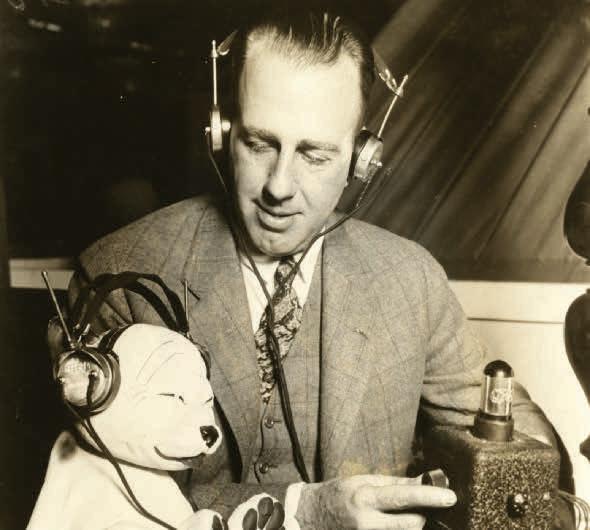
14 Echoes | NOVEMBER & DECEMBER 2022
Ohio History Connection Archival Collections
Ohio History Connection Archival Collections
Historic Sites & Museums
NORTHWEST OHIO

Armstrong Air & Space Museum
Cedar Bog Nature Preserve Cooke-Dorn House
Fallen Timbers Battlefield Memorial Park Fort Amanda Memorial Park Fort Jefferson Memorial Park Fort Meigs
Fort Recovery Museum & Monument Glacial Grooves Geological Preserve Hayes Presidential Library & Museums Indian Mill
Inscription Rock Petroglyphs Johnston Farm & Indian Agency Lockington Locks
NORTHEAST OHIO
Custer Monument
Fort Laurens McCook House Museum of Ceramics
Quaker Yearly Meeting House (Open by Appointment) & Free Labor Store/Benjamin Lundy House (Preservation in Progress • Not Open)
Schoenbrunn Village
Shaker Historical Museum Tallmadge Church
Youngstown Historical Center of Industry & Labor Zoar Village
SOUTHWEST OHIO
Adena Mansion & Gardens
Flint Ridge Ancient Quarries & Nature Preserve
Hanby House
Logan Elm Newark Earthworks Ohio History Center & Ohio Village Poindexter Village Historic Site (Preservation in Progress • Not Open) Shrum Mound
Wahkeena Nature Preserve Warren G. Harding Presidential Sites
Davis Memorial Nature Preserve Fort Ancient Earthworks & Nature Preserve Fort Hill Earthworks & Nature Preserve Harriet Beecher Stowe House John Rankin House Miamisburg Mound National Afro-American Museum & Cultural Center Paul Laurence Dunbar House Serpent Mound Story Mound U.S. Grant Birthplace U.S. Grant Boyhood Home & Schoolhouse William Henry Harrison Tomb
SOUTHEAST OHIO
Big Bottom Memorial Park Buckeye Furnace
Buffington Island Battlefield Memorial Park Campus Martius Museum
John & Annie Glenn Museum
Leo Petroglyphs & Nature Preserve National Road & Zane Grey Museum Ohio River Museum
Our House Tavern
OHIOHISTORY.ORG 15 CENTRAL OHIO
OHIO HISTORY CONNECTION
1. 2. 3. 4. 5. 6. 7. 8. 9. 10. 11. 12. 13. 14. 15. 16. 17. 18. 19. 20. 21. 22. 23. 24. 25. 26. 27. 28. 29. 30. 31. 32. 33. 34. 35. 36. 37. 38. 39. 40. 41. 42. 43. 44. 45. 46 47. 48. 49. 50. 51. 52. 53. 54. 55. 56. Ohio History Connection members enjoy free regular admission to these Ohio History Connection sites. Before traveling, visit ohiohistory.org/sites to confirm hours and any special requirements.

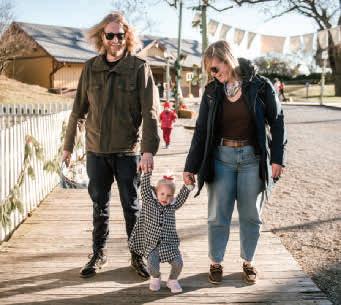

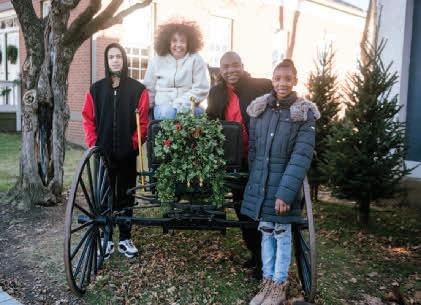


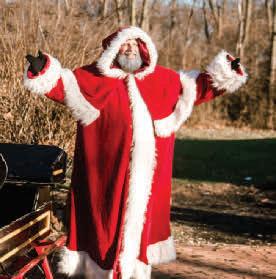

NOVEMBER & DECEMBER 2022 Dickens of a Christmas at Ohio Village Sat., Dec. 3, 10 & 17, 5:30–9 p.m. • Sun., Dec. 4, 11 & 18, 1–5 p.m.
tickets required. No on-site ticket sales. 800.686.1541 or ohiohistory.org/dickens
DICKENS OF A CHRISTMAS Dickens Dinners at Ohio Village
SAT., DEC. 3 & 17
& Ohio Village

Ohio History Center
OHIO HISTORY CENTER & OHIO VILLAGE March Through Time
SAT., NOV. 12 • 10 A.M.–5 P.M.
Travel through time as you explore the rich military history of Ohio, America and the world! Living-history reenactors representing soldiers of the Middle Ages through Modern Day will be on hand in the museum throughout the day. Enjoy a variety of related hands-on activities, and explore the world of miniature war-gaming, employing your knowledge of strategy and history on the board-gaming table. New this year: In Ohio Village, step back to the year 1946 to explore life from the perspective of service members returning from World War II. See what Ohio was like when they returned, and talk with them about their experiences. Included with Ohio History Center museum admission. Ohio History Connection members enjoy free admission. 800.686.6124 or ohiohistory.org/marchthroughtime
BONUS DAY! See life for those returning from World War II in Ohio Village on Sun., Nov. 13, too!

ASK A CURATOR Military Items & Photographs
SAT., NOV. 12 • 1–3 P.M.
Do you have items from family or friends who served in the military that you don’t know much about? Whether it’s an ancestor’s uniform or a box of photos that pose questions, come to the Ohio History Center on Saturday, Nov. 12, to learn more about them. Our curatorial team will be on hand to help you try to solve these mysteries of history. Note: Firearms and live or spent munitions of any kind aren’t permitted inside the Ohio History Center. If you have a firearm or munition you’d like
help in identifying during this program, please bring a photo of it with any other information you can share. Included with Ohio History Center museum admission. Ohio History Connection members enjoy free admission. 800.686.6124 or ohiohistory.org/marchthroughtime
Lustron House Decorated for the Holidays + Holiday Train Display
WEDS., NOV. 16–SUN., JAN. 8 Ohio History Center, Columbus 4 It’s Christmas, 1950s-style, in our real, fully furnished Lustron house! Drop by to see how Dottie and Bob have decorated and check out little Jimmy’s model train display, courtesy of Central Ohio Model Railroad Club. Included with Ohio History Center museum admission.
DICKENS OF A CHRISTMAS Dickens of a Christmas at Ohio Village
SAT., DEC. 3, 10 & 17 • 5:30–9 P.M. SUN., DEC. 4, 11 & 18 • 1–5 P.M. Capture the spirit of holidays past in our recreated 19th-century community, where Charles Dickens’s festive and enduring vision comes to life through jolly carols, decorations and traditions inspired by his colorful tales. Meet Scrooge, Jacob Marley and other characters from A Christmas Carol, plus Santa decked out in Victorian style. Pose in a sleigh for a unique holiday photo; enjoy craft and cooking demonstrations; buy wassail, cookies or roasted chestnuts; and shop P. Wylie’s Emporium for the perfect gift. $18, $14/ages 4–12 (Ohio History Connection member: $13, $9/member ages 4–12, Free/age 3 & under). Advance timed
TWO SEATINGS: 4:30 & 7 P.M. American House Hotel, Ohio Village, Columbus 4 Experience an evening in the world of Charles Dickens. Feast on a sumptuous dinner at the American House Hotel, then enjoy Dickens of a Christmas festivities throughout Ohio Village, included with admission. Each dinner guest receives a Christmas Cracker, a festive holiday tradition. $70, $60/Ohio History Connection member. Advance registration required. 800.686.1541 or ohiohistory.org/dickens
DICKENS OF A CHRISTMAS Dickens Brunches at Ohio Village
SUN., DEC. 4, 11 & 18
TWO SEATINGS: NOON & 2 P.M. American House Hotel, Ohio Village, Columbus 4 Savor a festive holiday buffet of splendidly prepared dishes in the warmth of the American House Hotel, then enjoy Dickens of a Christmas festivities throughout Ohio Village until 5 p.m., included with admission. $50, $35/ ages 4–12 (Ohio History Connection member: $40, $25/ages 4–12). Advance registration required. 800.686.1541 or ohiohistory.org/dickens
Kwanzaa
MON., DEC. 26 & SAT., DEC. 31 4–8 P.M.
Ohio History Center, Columbus Kwanzaa is a seven-day celebration that honors community, family and heritage of African American culture and African traditions. Kwanzaa comes from the Swahili word meaning “first harvest” and is based on the seven principles of Nguzo Saba. The Ohio History Connection and TAWI Family Village invite you to enjoy two festive evenings of Kwanzaa, featuring African drumming, live music, dance, storytelling and hands-on art activities. Free. 800.686.6124 or ohiohistory.org/ kwanzaa
OHIOHISTORY.ORG 17
PROGRAMS & EXHIBITS AT THE
*Museum admission is $16; $14/ages 60+ or student with ID; $10/ages 4–12. Ohio History Connection members and ages 3 & under enjoy free admission.
FEATURED EXHIBITS • • •
Indigenous Wonders of Our World—The Hopewell Ceremonial Earthworks
ONGOING
Indigenous Wonders of Our World looks at eight 2,000-year-old Hopewell earthworks in Ohio: Fort Ancient, near Oregonia and Lebanon; Newark’s Great Circle and Octagon; and Hopewell Mound Group, Mound City, Hopeton Earthworks, Seip Earthworks and High Bank Works, all near Chillicothe. Unique in the world, they’re the focus of a nomination now underway proposing that they be named World Heritage Sites by UNESCO, the United Nations Educational, Scientific and Cultural Organization. The exhibit looks at mathematical similarities among them, their enormous scale and their alignments to the solstices and/or the 18.6-year lunar cycle. An immersive component allows you to experience the astronomical alignments.
Ohio—Champion of Sports
ONGOING
Ohio—Champion of Sports features more than 70 stories and 35 oral histories covering more than 25 sports ranging from baseball, football and basketball to roller derby, skateboarding and e-gaming. The exhibit showcases the Ohio athletes, coaches, owners and fans at the center of the action and explores sports through the themes of Character, Adversity, Innovation, Identity, Tradition and Victory—values that relate to the human condition—to connect a broad audience to Ohio’s national sports history. You can test your basketball skills at the Wall of Hoops, record a “victory dance” to share with family and friends and record your own “One Minute Legends” sports story.
Votes for Women— 100 Years of Change
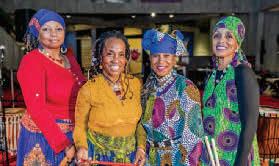
ONGOING
Votes for Women commemorates the 100th anniversary of the 19th Amendment. Through the voices of Ohio women, explore women’s activism in the suffrage movement and other related social movements—such as voting and citizenship—from the 19th century to the present. Featured are a suffrage parade blouse, jacket and sashes worn in the 1910s
March Through Time
by Mary Stuart Andrews of Warren, who worked for the Ohio Woman Suffrage Association, and a suffrage parade banner made in 1910 by Columbus Sign Co.
1950s—Building the American Dream
ONGOING
Get a look at life in the 1950s. Peek in the closets and snoop in the drawers of a real, fully furnished Lustron steel house made right here in Ohio. From the contents of the cupboards to the news on TV and the toys in the yard, this hands-on exhibit is a fascinating journey back in time.
World War I Display
ONGOING
See equipment, weapons, uniforms and memorabilia commemorating

Creative Ohio—Artists,
(1905–1969),
Hawkins (1895–1990)—and
(1913–2000) and
by
Trust.
18 Echoes | NOVEMBER & DECEMBER 2022 “““ NOV. 12
the centennial of World War I.
Artwork & Their Inspiration ONGOING Through pieces from Ohio History Connection collections, explore the artwork, inspiration and creative processes of four Ohio artists—Paul-Henri Bourguignon (1906–1988), Emerson Burkhart
Hayward Dinsmore
William
create your own artistic masterpiece. Support provided
the Erika Bourguignon Charitable
Mon., Dec. 26 & Sat., Dec. 31 4–8 p.m. OHIO HISTORY CENTER COLUMBUS Enjoy two free festive evenings of Kwanzaa, featuring African drumming, live music, dance, storytelling and hands-on art activities. 800.686.6124 ohiohistory.org/kwanzaa FREE ADMISSION In partnership with TAWI Family Village Sat., Nov. 12 • 10 a.m.–5 p.m. OHIO HISTORY CENTER & OHIO VILLAGE, COLUMBUS From Roman Gladiators to World War II GIs, meet and talk with 20+ living soldiers of times past throughout the museum. And for one special day, Ohio Village fast-forwards to 1946—see life as it looked to service members newly home from World War II. Included with museum admission. Ohio History Connection members enjoy free admission. 800.686.6124 • ohiohistory.org/march
Ohio History Center & Ohio Village Hours





Museum
WEDS.–SUN. 10 A.M.–5 P.M. CLOSED MON.–TUES.
CLOSES AT 4 P.M. SAT., DEC. 3, 10 & 17 CLOSED THANKSGIVING DAY CLOSED CHRISTMAS EVE & CHRISTMAS DAY
OPEN 4–8 P.M. MON., DEC. 26, WITH FREE ADMISSION
OPEN 10 A.M.–8 P.M. SAT., DEC. 31, WITH FREE ADMISSION 4–8 P.M.
OPEN 10 A.M.–5 P.M. NEW YEAR'S DAY
CLOSED FOR MAINTENANCE MON., JAN. 2 THROUGH FRI., JAN. 13



Ohio Village
OPEN FOR DICKENS OF A CHRISTMAS










SAT., DEC. 3, 10 & 17 • 5:30–9 P.M. SUN., DEC. 4, 11 & 18 • 1–5 P.M.



Third Floor Research Room
OPEN BY APPOINTMENT ONLY ohiohistory.org/learn/archives-library
WEDS. 12:30–3 P.M.
THURS. & FRI. 10 A.M.–3 P.M. CLOSED SAT.–TUES.
Plaza Cafe
OPEN WEDS.–SUN. 11 A.M.–2 P.M. The Plaza Cafe serves grab-n-go salads, sandwiches, sides and desserts, coffee, tea, juices and Pepsi products. Ohio History Connection members save 10% at the Plaza Cafe.

ATTEND FROM ANYWHERE!
Online Events
























FEATURED SPEAKER
Escape of the 28 from Boone County, Kentucky
SUN., NOV. 6 • 4–5:30 P.M.

Online—Attend from Anywhere! 4 Hosted by Harriet Beecher Stowe House, Cincinnati 4 During a blustery and wet April night in 1853, 28 enslaved men, women and children made a desperate flight to freedom from Boone County, Kentucky. Reportedly inspired by Uncle Tom’s Cabin and led by Wash Parker, their harrowing journey took them nearly 280 miles from the Ohio River into Canada. Who were these brave freedom seekers and what’s their story? Explore the escape of the Cincinnati 28 with featured speaker Bridget B. Striker, local history coordinator for the Boone County Public Library. 800.847.6507 or friends@stowehousecincy.org
MEMBER VIP
The Ohio History Connection Battle Flag Collection
TUES., NOV. 8 • 3 P.M.
Online—Attend from Anywhere! 4 Hosted by the Ohio History Connection’s Membership Department 4 Join History Curator Cliff Eckle for an in-depth look at the Ohio History Connection’s collection of Civil War battle flags. Learn why the flags were created, how they were used in battle, how the Ohio History Connection acquired the collection and how we care for the flags. To register, visit ohiohistory.org/flagcollection.
OHIOHISTORY.ORG 19
Current members save 20% on all new Ohio History Connection TEXT “OHIOHISTORY” to 44-321 ONLINE ohiohistory.org/give SCAN MAIL OHIO HISTORY CONNECTION 800 E. 17th Ave. Columbus, OH 43211 Our membership prices go up in January 2023. Consider renewing early. You never lose time on your membership when you do.
Events & Exhibits
Many programs and events at Ohio History Connection museums and attractions require advance registration. To register, call the number or visit the website listed with each program. Our online calendar offers more upto-date information about programs and events at Ohio History Connection museums and attractions. Find it at ohiohistory.org/calendar
Questions? Call 800.840.6127
Harding loved holiday get-togethers. Join us for a luncheon befitting the season, along with a program by Harding Sites Researcher Jon Andersen focusing on the Hardings’ holiday traditions. $25, $20/Ohio History Connection member. Advance tickets required: hardingpresidentialsites.org
NORTHEAST OHIO
NORTHEAST OHIO Poetry in the Mills
of work and income by using primary source documents. $10. 330.941.1314 or centerofindustryandlabor@gmail.com
Christmas in Zoar
SAT., DEC. 3 • 10 A.M.–6 P.M.
SUN., DEC. 4 • NOON–4 P.M.
CENTRAL OHIO
CENTRAL OHIO
See also Ohio History Center & Ohio Village, pages 16–18.
First Friday Tour of the Great Circle
FRI., NOV. 4 & DEC. 2 • 12:30 P.M. Great Circle Earthworks, 455 Hebron Rd., Heath 4 Tour the Great Circle with Ohio History Connection Senior Archaeologist Brad Lepper. Hear about its construction roughly 2,000 years ago by American Indians, its purpose and its inclusion in a pending nomination of Ohio’s Hopewell Ceremonial Earthworks to UNESCO’s World Heritage List. Free. Meet at the map in front of the Great Circle Museum. 614.297.2653 or ebartlett@ohiohistory.org
Christmas Open House
TUES., DEC. 6 • 7–9 P.M. THURS., DEC. 8 • 7–9 P.M.
SAT., DEC. 10 • 10 A.M.–2 P.M. Hanby House, Westerville 4 Enjoy festive holiday decorations while touring the 1850s home of the Hanby family. Sample refreshments and listen to live holiday music, including composer Ben Hanby’s Up on the Housetop. Free. Donations appreciated. 800.600.6843 or WHSPres@ westervillehistory.org
Holidays with the Hardings
SAT., DEC. 10 • 11:30 A.M.–1 P.M. Warren G. Harding Presidential Library & Museum, Marion 4 Warren and Florence
SAT., NOV. 5 • 10 A.M.–1 P.M. Youngstown Historical Center of Industry & Labor, Youngstown 4 Attention Girl Scouts: Art, STEM, and Ohio history combine in this exciting program led by museum staff, which includes a tour of the museum. Grab your favorite pen and notebook and get ready to create some poetry as you travel back in time! Explore Youngstown Historical Center of Industry & Labor’s maps, immigration records and photographs to learn about Michael McGovern, Ohio’s “puddler poet.” You’ll discover the kind of work he did in the steel mills and why it inspired him to become a poet. Learn about “Rosie the Riveters,” women employed as steel workers during World War II, and use their stories to inspire some of your own poetry to share with the group. Pack a sack lunch. Badge connections: Junior Scribe, Cadette Public Speaker (badges not included). $10. 330.941.1314 or centerofindustryandlabor@gmail.com
Steel Worker for a Day
SAT., NOV. 19 • 10 A.M.–1 P.M.
Youngstown Historical Center of Industry & Labor, Youngstown 4 Attention Girl Scouts: Entrepreneurship and Ohio history combine in this fun role-playing program led by museum staff. Program includes a tour of the museum. Pack a sack lunch. Badge connections: NEW Brownie Budget Builder, NEW Junior Budget Maker, Junior Playing the Past, NEW Cadette My Dream Budget (badges not included). Review how to budget while role-playing workers of differing levels
Zoar Village, Zoar 4 Tour this oneof-a-kind historic German separatist community, home of a 19th-century communal society, in all of its Christmas splendor and experience all the joy and cheer of the season. The village will be decked out for the holiday season. Selfguided tours will be available, and you’ll find extended shopping opportunities at the Zoar Store, Bakery, Bimeler Museum, Gartenhaus Shop and Stars of Zoar Co-op as well as some privately owned shops. The tree-lighting ceremony will take place on Dec. 3 at 6 p.m. $10, Free/ age 12 and under. 800.262.6195 or historiczoarvillage.com
NORTHWEST OHIO
NORTHWEST OHIO
World at War Miniature WarGaming Day
SAT., NOV. 5 • 9:30 A.M.–4 P.M. Fort Meigs, Perrysburg 4 Miniature war-gaming is a unique way to learn about history. Through tabletop military strategy games, learn and experience the challenges facing military commanders throughout all of history, from ancient to modern. This event is open to the entire family and suitable for all ages for a full day of fun, critical thinking and action. $5, $4/senior, $3/student, Free/Ohio History Connection member or age 5 & under. 800.283.8916, 419.874.4121 or info@fortmeigs.org
Veterans Day
FRI., NOV. 11 • 9 A.M.–5 P.M. Hayes Presidential Library & Museums, Fremont 4 Veterans enjoy free admission to the Rutherford B. Hayes home and museum on Veterans Day. The first tour of
20 Echoes | NOVEMBER & DECEMBER 2022
FEATURED OHIO HISTORY CONNECTION
Holidays at Adena
the home is at 9 a.m., and the last is at 4 p.m. The research library will be closed. 800.998.7737, 419.332.2081 or admin@rbhayes.org
Second Saturdays R 4 Kids
SAT., NOV. 12 & DEC. 10 • 9:30–11:30 A.M. Hayes Presidential Library & Museums, Fremont 4 This monthly program for kids in grades K–3 celebrates the 200th birthday of President Rutherford B. Hayes, which was in October 2022. Each month highlights an important time in the president’s life and features a different activity. The format is openhouse-style, so kids can stop by any time between 9:30 and 11:30 a.m. Free. 800.998.7737 or rbhayes.org
Christmas at the Johnston Farm
SAT., DEC. 3 • 6:30 P.M.
Johnston Farm & Indian Agency, Piqua Celebrate Christmas 19th-centurystyle with the Johnstons. Advance registration required. 800.752.2619 or johnstonfarmohio.com
Lights of Spiegel Grove
THURS., DEC. 8 • 6–8 P.M.
Hayes Presidential Library & Museums, Fremont 4 Be on hand when Spiegel Grove, the 25-acre estate of 19th president Rutherford B. Hayes, lights up for Christmas at 6:15 p.m. Sip hot chocolate and snack on popcorn by the campfire. See the annual Hayes Train Special model train display and enter the gingerbread house contest (rules and entry forms at rbhayes.org). Free. South
Creek Clydesdales will offer horse-drawn sleigh and trolley rides for $5.50/person (sleigh), $4.50/person (trolley) and Free/ age 2 & under. Enjoy Christmas-themed first-floor tours of the president’s home for $10, $8/ages 6–18 and Free/age 5 & under. Buy recommended advance sleigh, trolley and house tour tickets at rbhayes. org. Remaining tickets will be for sale on the day of the event, pending availability. 800.998.7737 or rbhayes.org
Fort Meigs Holiday Open House
SUN., DEC. 11 • NOON–5 P.M. Fort Meigs Visitor Center, Perrysburg 4 Join us in the Visitor Center to celebrate the holidays. War of 1812 soldiers and civilians will be on hand to offer demonstrations and answer questions about the war and camp life. Enjoy holiday music, refreshments and handson activities, and shop our museum store for unique holiday gifts. Free. 800.283.8916 or fortmeigs.org
Sleigh and Trolley Rides
Through Spiegel Grove
DEC. 26, 27, 28, 29, 30 & 31 • 1–4 P.M. Hayes Presidential Library & Museums, Fremont 4 Ride through the wooded grounds of the President Rutherford B. Hayes estate in a horse-drawn sleigh, as he did when he lived there. A horse-drawn trolley will offer rides, too. The sleigh seats four people, and the trolley seats 16 to 18. The rides are a nostalgic trip through the beautiful wooded estate, past the Victorian Hayes Home and down Lover’s Lane, a favorite pine-tree-lined spot on the grounds. The last ride leaves at 3:45 p.m. Sleigh tickets are $5.50/rider age 3 and older and free age 2 and younger. Trolley tickets are $4.50/rider age 3 and older and free age 2 and younger. Buy advance tickets at rbhayes.org. Tickets will also be for sale at the front desk on the days of the event, pending availability. 800.998.7737 or admin@rbhayes.org
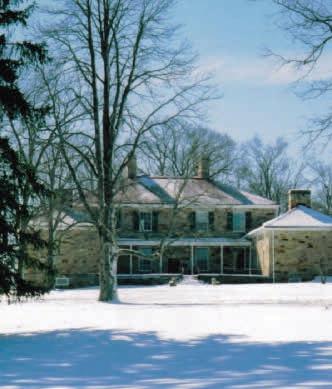
FEATURED EXHIBITS • • •
Hayes Train Special Model Train Display
FRI., NOV. 25–SUN., JAN. 8 • VISIT RBHAYES.ORG FOR DAYS AND HOURS Closed Christmas Eve, Christmas Day and New Year’s Day 4 Hayes Presidential Library & Museums, Fremont 4 See model trains running through a winter
holiday wonderland. Interactive buttons allow visitors to control aspects of the trains’ movements along the winding, multi-tiered layout. Access to Hayes Train Special is free. Donations will be accepted. 800.998.7737 or admin@rbhayes.org
Mustering Memory—160 Years of Saluting the Civil War
ONGOING THROUGH APRIL 30
Hayes Presidential Library & Museums, Fremont 4 From the aged veterans who walked on the fields of Gettysburg to commemorate its 50th anniversary in 1913, to modern enthusiasts who use vacation time reliving famous battles or scouring Civil War antique shows, this exhibit explores the history of how people have chosen to—and still choose to—remember the Civil War. Featuring items from Hayes collections, the exhibit also shares information about Civil War reenacting and memorabilia collecting. 800.998.7737 or rbhayes.org
SOUTHEAST OHIO
SOUTHEAST OHIO Appraisal Clinic
SAT., NOV. 12 • 10 A.M.–2 P.M.
Campus Martius Museum, Marietta Have you ever wondered whether that knickknack you’ve been dusting all these years is valuable? Is it something to pass on to your children? Should you insure it? Have your questions answered by Andrew Richmond, a professional in the field of antiques and appraisals. $5 donation per item. Proceeds benefit Campus Martius Museum. 800.860.0145 or mariettamuseums.org
Buckeye Furnace Gift Shop Pre-Holiday Sale
SAT., NOV. 19 & SUN., NOV. 20
10 A.M.–5 P.M.
Buckeye Furnace, near Wellston 4 Shop the gift shop at historic Buckeye Furnace on these two special days for unique Christmas gifts and decorations. We’ll be hosting a few select vendors with their skillfully made and unique inventories. If it’s unique or one of a kind, you can find it at Buckeye Furnace. 800.860.0144
OHIOHISTORY.ORG 21
“““
ADENA MANSION & GARDENS, DEC. 3, 4, 10 & 11
Adena Mansion & Gardens
SOUTHWEST OHIO
Scrapbooking Crop
FRI., NOV. 4–SUN., NOV. 6 FRI. & SAT. 9 A.M.–9 P.M. SUN. 9 A.M.–4 P.M. Adena Mansion & Gardens, Chillicothe Join us for a three-day retreat and scrapbook those wonderful memories of families, friends, vacations and more. You’ll have a personal six-foot table with electrical and Wi-Fi access. Vendors will be on hand Friday and Saturday with interesting booths, and everyone will receive a welcome gift and be eligible to win door prizes. Friday and Saturday include lunch, dinner and snacks. Sunday includes snacks. $130/person includes all three days or $60/Friday, $60/Saturday and $25/Sunday. Reservations and advance payment required. 800.319.7248 or info@adenamansion.com
Trees, Please
SAT., NOV. 5 • NOON–4 P.M. Fort Ancient Earthworks & Nature Preserve, near Oregonia and Lebanon 4 Study trees and forest ecology with Keith Bengtson of the Ohio History Connection. Learn how to identify trees and measure them, how each type is used and how foresters count all the trees of a type in a given area. Included with Fort Ancient site admission: $7, $6/senior or student, Free/Ohio History Connection member. 800.283.8904 or ohiohistory.org/fortancient

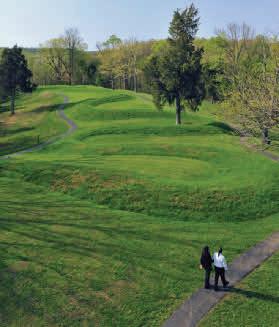


Craft and Crop for a Cause
SAT., NOV. 12 • 9 A.M.–9 P.M. Adena Mansion & Gardens, Chillicothe Circleville’s Creative Chaos and Chillicothe’s Adena Mansion & Gardens partner to host a crafting crop. Each crafter will receive a
and have the
a fun make-and-
Chaos, which will have shopping available as well. Throughout the
we’ll award door prizes. Lunch, dinner and snacks provided. $60/crafter. Reservations and advance payment required. Proceeds benefit Adena Mansion & Gardens educational programming. 800.319.7248 or info@adenamansion.com
Holidays at Adena
SAT., DEC. 3 & SUN., DEC. 4 10 A.M.–4 P.M.
SAT., DEC. 10 & SUN., DEC. 11 10 A.M.–4 P.M.
Adena Mansion & Gardens, Chillicothe Step back two centuries on a special holiday tour of the 1807 home of early Ohio governor Thomas Worthington. Closed for the winter season, Adena re-opens for the holidays on these two weekends only. Enjoy guided tours of the decorated mansion every half hour starting at 10:30 a.m., with the last tour at 3 p.m. Nearby, the Tenant House will be decorated to reflect German traditions brought to Adena by indentured servants who worked on the hilltop estate, and there will be craft activities for children. At the Visitor Center, enjoy live entertainment and refreshments, and shop for toys, books, decorations and gifts. $10, $5/child. Horse-and-carriage rides available at an additional charge. On Children’s Weekend, Dec. 10 & 11, one child will be admitted free with each paid adult admission. Buy tickets at the door or at 800.319.7248, info@adenamansion. com or adenamansion.com.
HOLIDAYS AT ADENA Wreath Workshops
SAT., DEC. 3, SUN., DEC. 4 & SAT., DEC. 10 Adena Mansion & Gardens, Chillicothe Decorate a wreath for the holidays at one of three sessions each day. We provide the evergreen wreath as well as natural materials gathered from the grounds of Adena Mansion & Gardens. You may also bring personal mementos to decorate your wreath. $35/ person. Advance registration required. 800.319.7248 or adenamansion.com
Winter Solstice Sunrise
WEDS., DEC. 21 • GATES OPEN 7:15 A.M. PROGRAM 7:30 A.M.
Fort Ancient Earthworks & Nature Preserve, near Oregonia and Lebanon 4 Experience the solstice as ancient people may have done 2,000 years ago. With the leaves fallen and trees bare, you’ll be able to clearly see Fort Ancient’s 2,000-year-old earthen walls as the sun rises between them on the shortest day of the year. Free. 800.283.8904 or ohiohistory.org/ fortancient
22 Echoes | NOVEMBER & DECEMBER 2022
welcome gift
opportunity to create
take with Creative
day,
WE HAVE Support, renew or find it at ohiohistory.org AT THE OHIO HISTORY CENTER & OHIO VILLAGE BOOK YOUR PARTY TODAY! 614.297.2475 events@ohiohistory.org OHIO HISTORY CONNECTION MEMBERS RECEIVE A 15% DISCOUNT ON FACILITY RENTALS. SOUTHWEST OHIO
Winter Solstice Sunrise
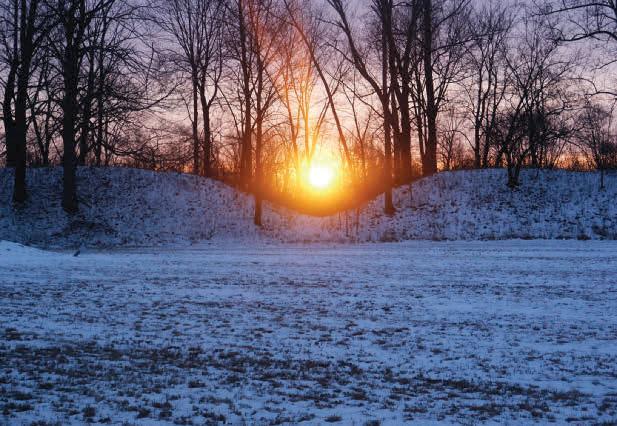
FEATURED EXHIBITS • • •
2022 Art of Soul! Juried Art Show
THROUGH SAT., FEB. 25 WEDS.–SAT. 9 A.M.–4 P.M. National Afro-American Museum & Cultural Center, Wilberforce 4 See an annual juried exhibit featuring works created by artists from across the United States in response to this year’s theme, Black Love. Also on exhibit: African Americans Fighting for a Double Victory; Behind the Mask—Black Power in Comics; Queens of the Heartland; Rhythm of Revolution; and What’s in Your Attic? Selections from Our Permanent Collection, including a special miniexhibit, Playing with Identity—Selections from the Lillian M. Bartok Black Doll Collection. Included with museum admission: $6, $5/senior, $3/ages 6–17, Free/Ohio History Connection member or age 5 & under. 800.752.2603 or ohiohistory.org/naamcc
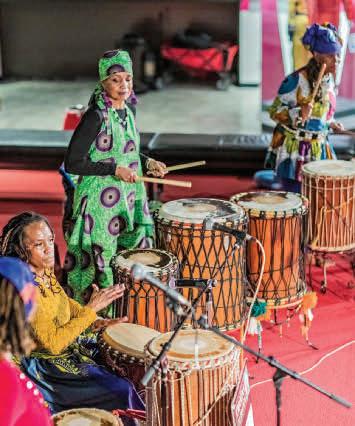
PAUL LAURENCE DUNBAR 150TH Paul Laurence Dunbar— Diamond of the Gem City
THROUGH SUN., JAN. 8
FRI.–SUN. 10 A.M.–4 P.M. Visitor Center, Paul Laurence Dunbar House, Dayton 4 See a new exhibit exploring Paul Laurence Dunbar’s life, work and legacy. Born in Dayton in 1872, Dunbar became one of America’s greatest poets, whose work later fueled a Black literary revolution. His life was marked by personal triumph and inherited trauma, both of which left indelible impressions on the world around him. This exhibit puts that life in context and positions him within a community of African American activists, including Alice DunbarNelson, Hallie Quinn Brown, Frederick Douglass and Brig. Gen. Charles Young, framing him not just as a hero, but also as a human whose flaws help tell a more complete version of our American story. Free. 937.225.7705 or ohiohistory.org/dunbar
ECHOES MAGAZINE
What We Include in the Calendar
The Ohio History Connection has some aspect of involvement in all of the events you see in our Echoes Magazine calendar. Many take place at the Ohio History Center & Ohio Village or one of our 50+ museums and attractions across Ohio (see page 15). Others, like Statehood Day or our Building Doctor Clinics, are sponsored by the Ohio History Connection or co-sponsored in partnership with other organizations.
Why do we limit the calendar to these events? With more than 700 history-related organizations in Ohio, you can probably imagine that without drawing the line somewhere, the calendar would become much longer, so some clear association with the Ohio History Connection is the criterion we use.
There are many, many more events worthy of your attention that are sponsored by local historical societies, museums and related organizations in Ohio. We encourage you to visit the websites of the history- and preservation-related organizations in your vicinity or your area of interest for information on those events. Better yet, join them—they need, deserve and appreciate your support, as do we.
OHIOHISTORY.ORG 23
OHIO HISTORY CENTER, COLUMBUS, DEC. 26
& 31
FORT ANCIENT, DEC. 21
Kwanzaa
Fort Ancient Earthworks & Nature Preserve
 BY MARCI RICH
BY MARCI RICH
At 101, Cleveland’s Playhouse Square Still Dazzles
Seated at an elegant desk, a bespectacled Joseph Laronge faces the camera. With his bow tie and banker’s look, the great real estate developer is the embodiment of early 20th-century success. His downtown silent-film theatres were triumphs, which kindled his dream of transforming Cleveland into an entertainment powerhouse.
By 1916, according to Kathleen Kennedy, author of Playhouse Square: Cleveland, Ohio, Laronge envisioned a stretch of Euclid Avenue from Ninth to 17th streets as an “elegant promenade,” with restaurants, fine shops and “a line of magnificent playhouses.”
He devised seminal partnerships with, among other notables, motion picture magnate Marcus Loew. Within five years, several palatial theatres would be completed or under construction in America’s fifth-largest city, thus earning Laronge his place in history as the “Father of Playhouse Square.”
Beginning on Feb. 5, 1921, and over the next 19 months, the State, Ohio, Hanna, Allen and Palace theatres opened their doors to devotees of vaudeville, movies and legitimate theatre.
These grand palaces enhanced the cultural life of the city for decades. But a devastating July 1964 fire at the Ohio Theatre, followed by Laronge’s death at 82 that October, could have been, in hindsight, a dismal harbinger of the future.
Ensuing years of vandalism and neglect took their toll, and from May 1968 through July 1969, four theatres closed, entombing the opulence within. By 1972, the Ohio and the State theatres were slated for demolition. Only the Hanna limped along, finally closing in 1988.
These grand palaces enhanced the cultural life of the city for decades.
How to calculate the cost of such an erasure from the streetscape?
“It is widely understood in Cleveland that losing the Playhouse Square theatres would have been a disaster for the city,” Steven Litt, art and architecture critic of The Plain Dealer, writes in an email. “The battle
The 320-foot lobby of the KeyBank State Theatre, shown here in 2016, is one of the longest in the world. Designed by New York architect Thomas Lamb, the State opened on Feb. 5, 1921.
OHIOHISTORY.ORG 25
Ken Blaze | Courtesy of Playhouse Square
to save the theatres was a turning point in the fight to keep downtown alive in an era of white flight and suburban sprawl enabled by interstate highways. Losing the theatres would have set that effort back by decades.”
Armies of artisans and architects, corporate and civic leaders, visionaries and volunteers took up that battle. To understand what they were fighting to save, here’s a brief look at each theatre, followed by a glimpse of the landmark moments leading to Playhouse Square’s rebirth.
FIVE CULTURAL PALACES
The State Theatre (Feb. 5, 1921) is considered one of the finest theatres ever designed by Thomas Lamb. In fact, Marcus Loew arranged for two trainloads of film celebrities to attend its gala opening. The State’s 320-foot lobby, one of the longest in the world, features a pair of marble staircases ascending to the mezzanine level. Magnificent 50-foot-long murals painted by American modernist James Daugherty adorn its walls. Today it’s known as the KeyBank State Theatre.
The Ohio Theatre (Feb. 12, 1921), also designed by Thomas Lamb, was another showstopper, with exquisite ornamentation, a Venetian ceiling, mahogany pillars and murals painted by the Italian artist Sampitrotti. The Ohio’s offerings ranged from out-of-town dramatic plays like Eugene O’Neill’s Strange Interlude to musical extravaganzas like the Ziegfeld Follies. Today it’s called the Mimi Ohio Theatre.
The Hanna Theatre (March 28, 1921) opened with a stage adaptation of Mark Twain’s The Prince and The Pauper. Built by Daniel Rhodes Hanna, it was named to honor his late father, U.S. Senator Marcus A. Hanna. Architect Charles A. Platt designed it in the Italian
Renaissance style, with bronze trimming, marble corridors and a Roman-coffered ceiling. The Hanna was the only “road theatre” in the country to keep its lights on during the Great Depression.
The Allen Theatre (April 1, 1921) was named for brothers Jules and Jay Allen, operators of the largest chain of theatres in Canada and one of the first major theatres in the world built exclusively for films. Designed by C. Howard Crane in a truer Italian Renaissance style than the State or the Ohio, the 45-foot rotunda in its lobby was originally followed by a 60-foot elliptical dome, with a connecting open colonnade on the second level leading to the balcony. The ellipse was sealed over during a 1998 conversion to conform with modern fire codes, and it’s now the mezzanine bar, says Tom Einhouse, vice-president of Facilities and Capital for Playhouse Square.
The architectural firm of C.W. and George Rapp designed the Palace Theatre (Nov. 6, 1922) in the style of Imperial France. Edward Albee, father of the famous playwright, had set his sights on Cleveland for a new vaudeville house on the Keith circuit, and Fanny Brice, Harry Houdini and Sophie Tucker were among the headliners to play the Palace. Two sweeping Carrara marble staircases and five imported Czechoslovakian crystal chandeliers, replicas of those at Versailles, grace the lobby of what is now the Connor Palace.
Much more than buildings, these theatres are, as Kennedy wrote, historic objects worthy of conservation. Thomas Lamb, Charles A. Platt, C. Howard Crane and C.W. and George Rapp were among the leading movie palace designers in the U.S. at the time.
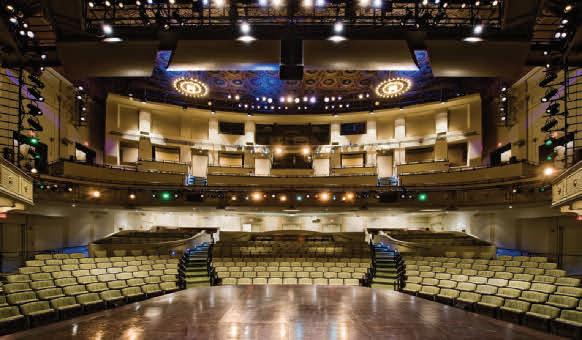
Left: The 1921 Hanna Theatre at Playhouse Square as seen from the stage. Restoration of the Hanna Theatre by DLR Group | Westlake Reed Leskosky received an Award of Merit from the Ohio History Connection’s State Historic Preservation Office in 2014.
Right: Detail of the Mimi Ohio Theatre lobby, featuring the restoration work of DLR Group and EverGreene Architectural Arts of New York. The restoration received an Award of Merit from the Ohio History Connection’s State Historic Preservation Office in 2017.
26 Echoes | NOVEMBER & DECEMBER 2022
Courtesy
of Playhouse Square
Photo by Kevin G. Reeves, courtesy of DLR Group



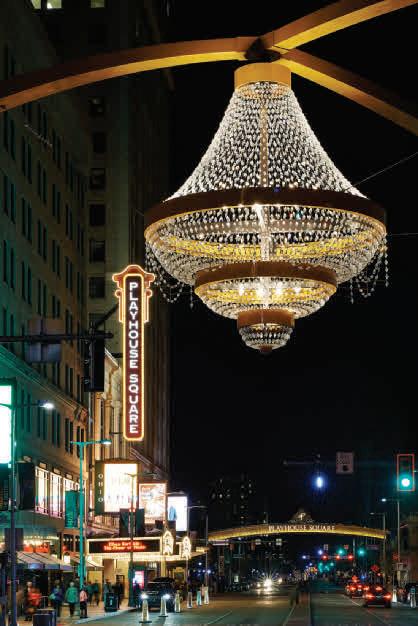 Roger Mastroianni Courtesy of Playhouse Square Archives, Michael Schwartz Library Special Collections, Cleveland State University
Ohio History Connection Archival Collections
Roger Mastroianni Courtesy of Playhouse Square Archives, Michael Schwartz Library Special Collections, Cleveland State University
Ohio History Connection Archival Collections
“A SIGN FROM THE HEAVENS”
Fortune, it’s said, favors the bold, and Seattle native Ray Shepardson, a Cleveland Board of Education employee, was nothing if not bold. He discovered the darkened theatres on Feb. 5, 1970 (the 49th anniversary of the State’s opening), while seeking a venue to host a teacher-training session. Their faded, antique grandeur ignited his imagination. Then, at his barbershop, an issue of Life magazine caught his eye. Featured on the Feb. 27, 1970, cover was the James Daugherty mural from the State Theatre he’d seen just weeks earlier. “It was a sign from the heavens,” writes Michael Routa in A History of Cleveland’s Playhouse Square.
Shepardson engaged in relentless networking to save the theatres, kindling the interest of civic leaders and groups—in particular, the Junior League. By that summer, the Playhouse Square Association (now the Playhouse Square Foundation) was formed. Charter membership grew to 400, and something resembling hope began to waft back into the moribund theatres.
But in 1972, developers targeted the Ohio and State theatres for demolition to make way for a large parking lot. This impending destruction was the catalyst for the preservationists’ efforts; a winning lawsuit pertaining to curb cuts on Euclid Avenue granted the buildings a stay of execution.
After the tide turned, it was time to raise funds, forge partnerships and restore the square. It was time for live theatre to return to Playhouse Square.
ALIVE AND WELL
On April 13, 1973, after teams of volunteers worked tirelessly to clean and patch and paint, the onceshuttered Grand Lobby of the State Theatre was ready for its close-up: the opening of a cabaret production of Jacques Brel is Alive and Well and Living in Paris. A critical and box-office smash, Brel ran for two-and-a-half years (it’s arguably the longest-running show in Cleveland history) and is credited with sparking Playhouse Square’s rejuvenation.
With careful, early planning—especially by Cleveland architect Peter van Dijk—and with the support of corporations, foundations and philanthropists, over the decades the Playhouse Square Foundation has lovingly refurbished, restored and revitalized each historic theatre, guided by the philosophy that a civilization’s art heritage must be preserved. Each theatre’s restoration is worthy of its own article, but the saga of the fire-ravaged, on-the-brink-ofdestruction Ohio Theatre is especially poignant.
The Loew Corporation typically refreshed its theatres every 10 years, explains Tom Einhouse, vice president of facilities and capital at Playhouse Square, adding that Loew’s had totally renovated the Ohio shortly before the 1964 fire. Afterwards, “it was all gone.”
A stopgap restoration of the Ohio took place in the 1980s. Then, says Einhouse, “beginning in 2015, we gutted the whole thing … we reconstructed everything from scratch.” The project was completed in 2016.
During a recent tour, Einhouse’s admiration for the work done by Cleveland architectural firm Westlake Reed Leskosky (now DLR Group) and EverGreene Architectural Arts of New York is evident, admiration that is echoed by critic Steven Litt. (The Ohio is his favorite theatre.)
In an email, he writes that the restoration team “beautifully recreated” the lobby. “The designers pulled molds off remaining fragments of original plaster ornamentation to recreate Lamb’s original design in all its glory.”
DAZZLING
One hundred and one years on, Playhouse Square, listed in the National Register of Historic Places, is a shimmering theatre, entertainment and media district—an economic engine of tourism and arts education, with partnerships that include, to name a few, Cleveland State and Case Western Reserve universities, the Cleveland Play House and Great Lakes Theater and Ideastream Public Media.
Top: Night view of Playhouse Square theatres, about 1940. Bottom (left): At 20 feet tall, the GE Chandelier installed at Playhouse Square in 2014 is the largest outdoor chandelier in North America. Bottom (right): Joseph Laronge, “Father of Playhouse Square.”
OHIOHISTORY.ORG 29
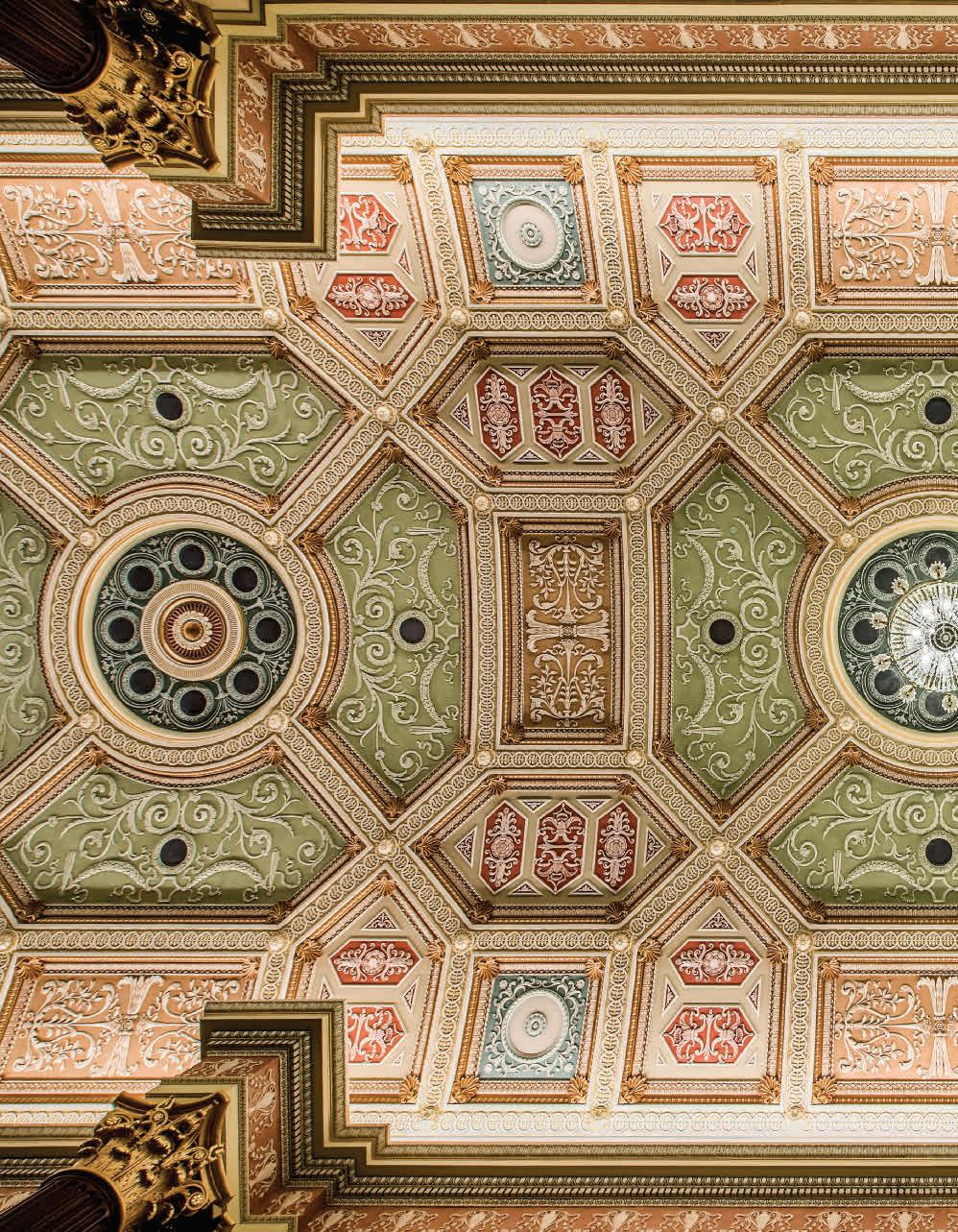 Restored ceiling of the lobby in the 1921 Mimi Ohio Theatre at Playhouse Square.
Photo by Kevin G. Reeves, courtesy of DLR Group
Restored ceiling of the lobby in the 1921 Mimi Ohio Theatre at Playhouse Square.
Photo by Kevin G. Reeves, courtesy of DLR Group

It’s the country’s largest performing arts center outside of New York City, and Cleveland is one of only a handful of U.S. cities able to present touring Broadway shows for longer than three weeks. Prepandemic, the complex welcomed more than one million people annually to its current configuration of 11 performance spaces.
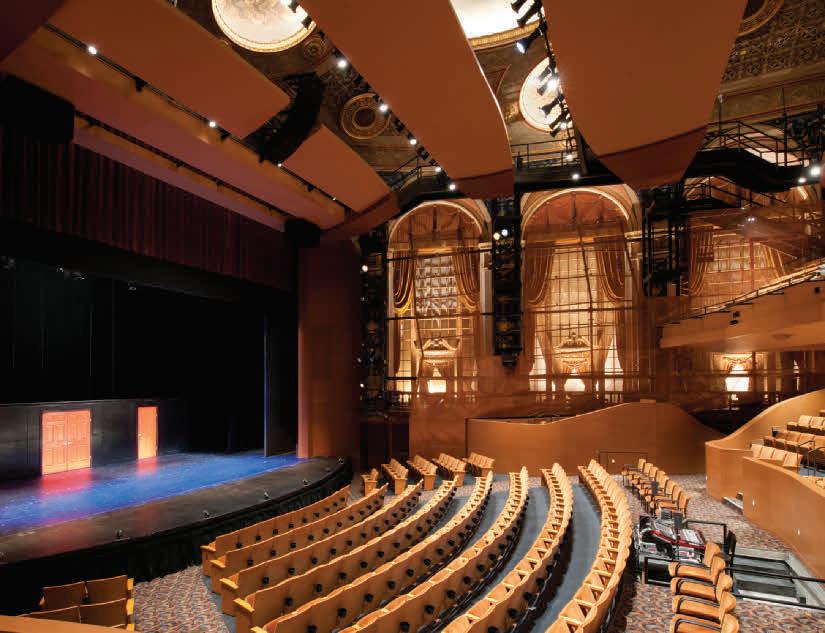
It’s also, by design, a vibrant neighborhood of restaurants, hotels and apartments, with the largest outdoor chandelier in North America suspended over Euclid Avenue at East 14th Street. In defiance of those dark years, and in spite of a pandemic, not only do the lights of Playhouse Square remain on, they dazzle.
Marci Rich is the author of Looking Back at Elyria: A Midwest City at Midcentury, published by the History Press.

In defiance of those dark years, and in spite of a pandemic, not only do the lights of Playhouse Square remain on, they dazzle.

32 Echoes | NOVEMBER & DECEMBER 2022
Playhouse Square’s Allen Theatre opened April 1, 1921.
Photo by Kevin G. Reeves, courtesy of Playhouse Square
LEARN MORE
Online: playhousesquare.org
In print : A History of Cleveland’s Playhouse Square by Michael Routa (The History Press, 2021), Playhouse Square: Cleveland, Ohio by Kathleen Kennedy (Playhouse Square Foundation, 1975) and Playhouse Square Cleveland: An Entertaining History, 1810 to the 21st Century by Kathleen Kennedy and Jean Emser Schultz (Playhouse Square Foundation, 2000)
Designed by the Chicago architectural firm of Rapp & Rapp, the Palace Theatre, now known as the Connor Palace, was the last of five Playhouse Square theatres to open in 1921 and 1922 when it debuted on Nov. 6, 1922.
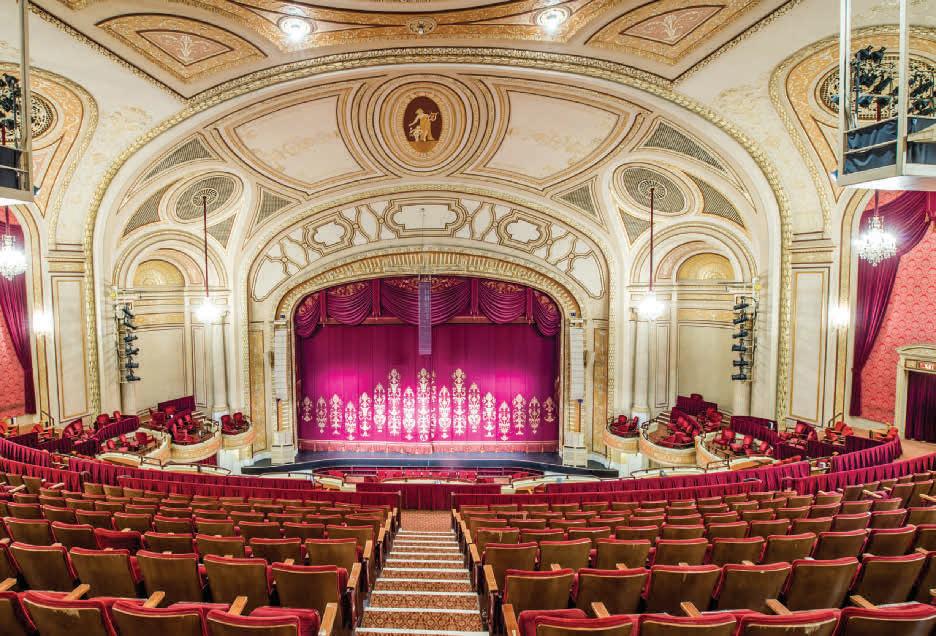
WATCH
It’s hard to show you all of Playhouse Square in a few short pages. Scan this QR code with your phone’s camera to watch a short Echoes Extras companion video about the five century-old theatres at Playhouse Square and get a look inside them.
OHIOHISTORY.ORG 33
LEARN MORE
Courtesy of Playhouse Square
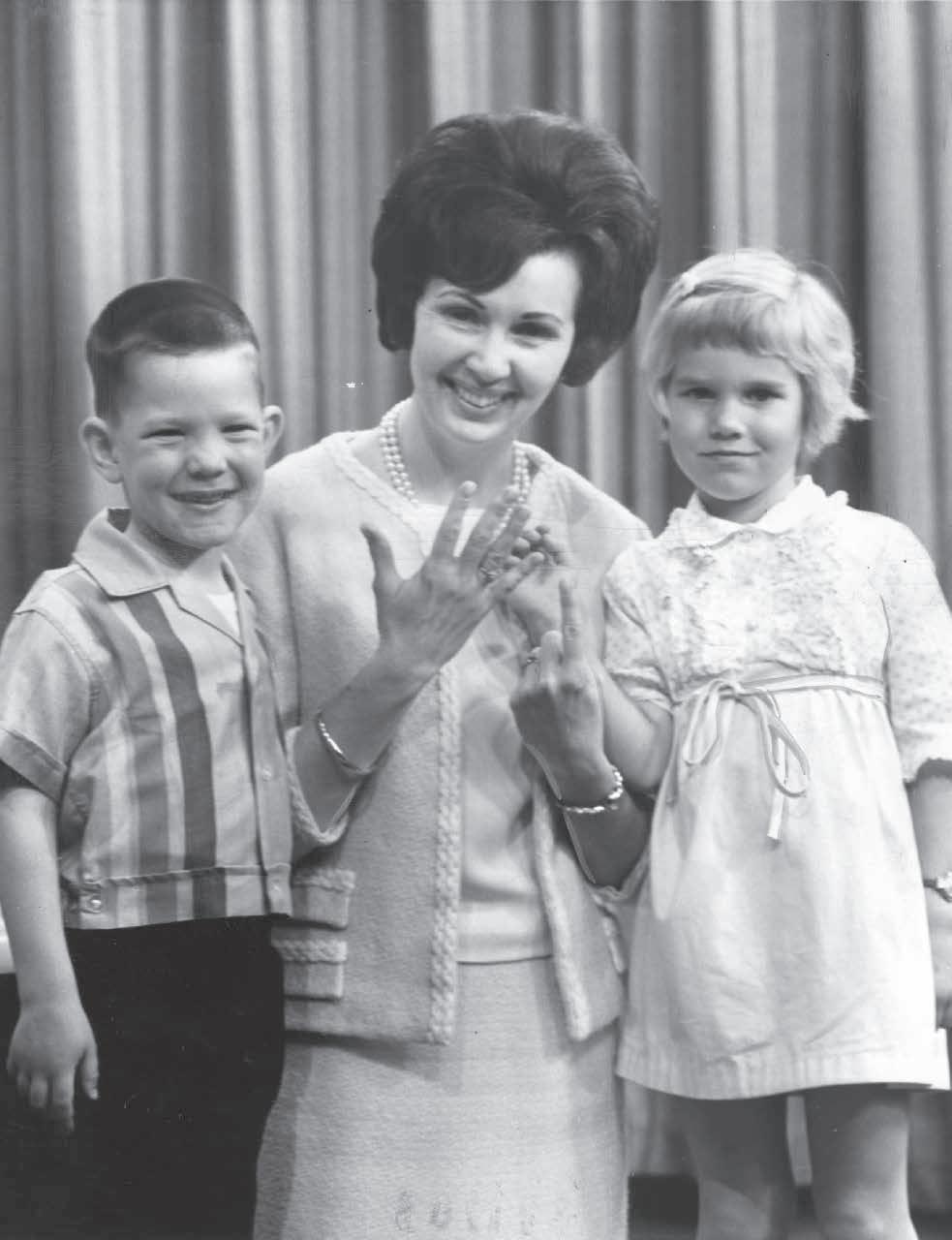
Sign-On Pioneer
WEWS, OHIO'S FIRST TV STATION BY TIM FERAN
This is television station WEWS, your Scripps Howard station, first in Cleveland. WEWS operates on Channel 5 from 76 to 82 megacycles and maintains studios on East 13th Street in downtown Cleveland. On this, the first telecast in Ohio, we take you to Public Hall for the annual Cleveland Press Christmas party with Jimmy Stewart.”
With those words, on Dec. 17, 1947, WEWS became the first television station in Ohio to sign on the air and the 16th to sign on in the United States.
This year, as the station celebrates its 75th anniversary, it’s instructive to look back and recall the impressive number of firsts that WEWS achieved during its early years, how the station continued to be a leader among local stations over the ensuing decades and how, as the local television industry undergoes fundamental changes, WEWS faces a future that has echoes of its past.
From the beginning, WEWS was different from other early stations. Its call letters, for example, weren’t just randomly chosen but denoted the initials of its parent company’s founder, Edward Willis Scripps. The station leveraged its corporate connections in its first broadcast by airing the Christmas pageant run by its corporate newspaper cousin, The Cleveland Press.
That connection to news reporting has been important to WEWS throughout its history. During a blizzard in the early years of the station’s existence, for example, WEWS provided extended coverage of conditions throughout the city. One of the station staff who worked at WEWS during that blizzard was Betty Cope, who later became the founding president and general manager of Cleveland public TV station WVIZ, says Mark Dawidziak, a longtime TV critic for the Akron Beacon Journal and the Cleveland Plain Dealer.
From the beginning, WEWS was different from other early stations.
ANY HORSE IN A STORM
“There’s a famous story of Cope riding a horse during the snowstorm to get to the station,” Dawidziak says. Cope was producing a Christmas show with Santa Claus and didn’t want to disappoint Cleveland’s children, Dawidziak says, and so, determined to make it from her home in Shaker Square to the station, she saddled up a horse and rode in for the broadcast.
Left: Miss Barbara celebrates her anniversary on Romper Room in 1966 with help from four-year-olds Jeff Hershman and Tammy Tilker.
Photos courtesy of WEWS and Cleveland Memory
OHIOHISTORY.ORG 35
Cope was one of several pioneering women broadcasters at WEWS, a group epitomized by Dorothy Fuldheim.
Fuldheim, who’d been with WEWS before it had even signed on, was the first woman in the United States to have her own TV news analysis program. She also was host, along with Bill Gordon, of a 90-minute weekday afternoon variety show, The One O’Clock Club, that became the template for other daytime talk-and-variety programs.
But it was her role as a news commentator, a position that Fuldheim held until suffering a stroke at age 90 in July 1984 after her 6 p.m. program, that made her a legend in broadcasting.
“Dorothy Fuldheim does not get the attention in broadcast history, in journalism history and in history-history that she deserves,” says Robert Thompson, professor of television, radio and film and director of the Bleier Center for Television and Popular Culture at Syracuse University’s S.I. Newhouse School of Public Communications.
“She was not only reporting the news on television, but doing news commentary, something that we associate with today’s cable news channels—and she was a woman in a business that, at the time, had very few women.
“She was in a class of her own.”
EXERCISING, COOKING AND KIDS
During the early years of television, networks offered a limited number of shows for affiliates, so WEWS— like many other local stations across the country— produced much of its own programming.
There were exercise programs hosted by a leotardclad Paige Palmer; a live cooking show with Alice Weston; and children’s programs, including the Cleveland franchise of Romper Room, which at WEWS featured Barbara Plummer as “Miss Barbara”; as well as original shows featuring Ron Penfound wearing a railroad conductor’s cap as “Captain Penny” and Gene Carroll as “Uncle Jake.”

Carroll, like so many other station staff, did double duty as the host of The Gene Carroll Show, a popular program that presented Cleveland-area
A caption on the back of this circa 1960 photo reads: “Reintroduced to the accordion after many years, Jimmy Stewart’s fingers quickly found a melody as other accordion players from The Press Christmas show cast joined in.”
36 Echoes | NOVEMBER & DECEMBER 2022
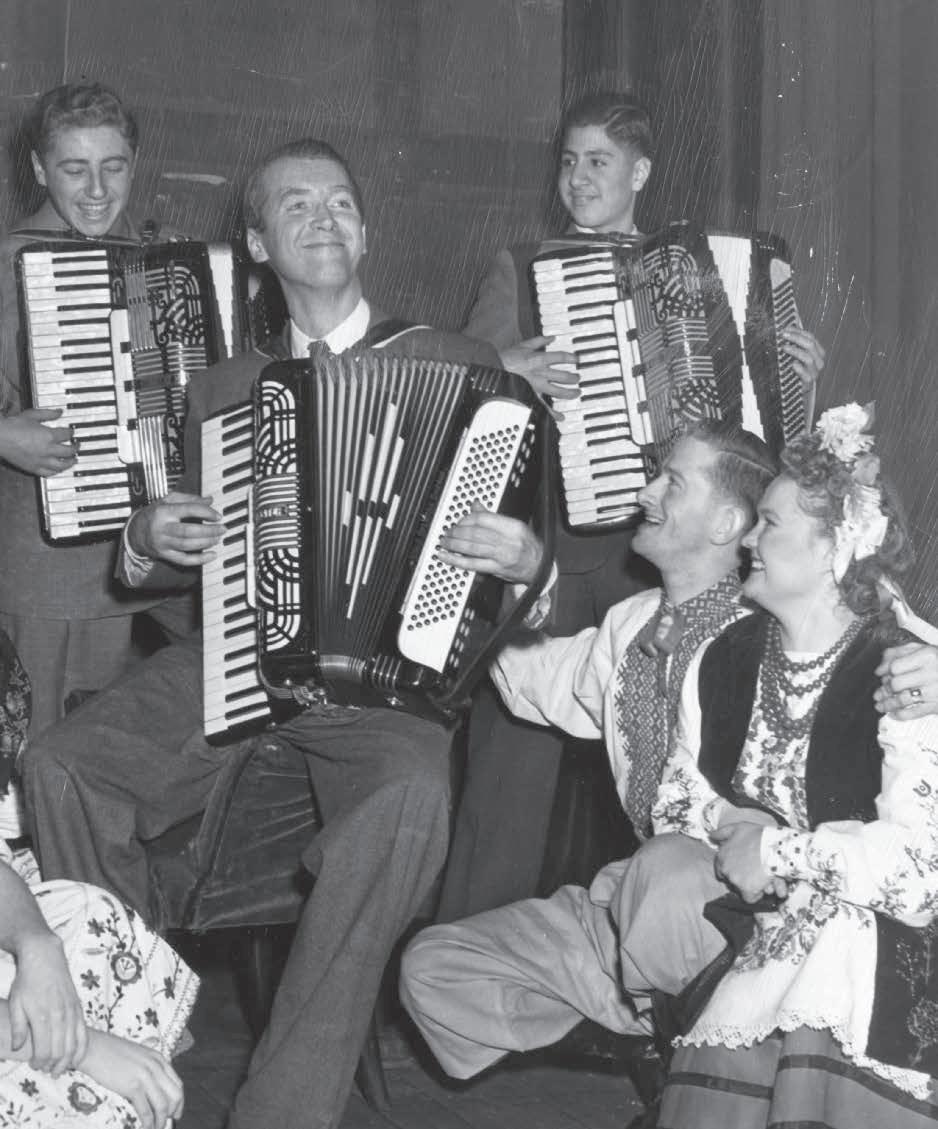
OHIOHISTORY.ORG 37
In 1963, the One O'Clock Club, an afternoon talk show hosted by WEWS news commentator Dorothy Fuldheim, featured five videotaped conversations with Bob Hope.

performers every Sunday at noon. The show premiered in 1948 and aired into the 1970s.
Beginning in the early years and continuing to recent years, WEWS has been first in both the city or state in a number of areas—the first live remote broadcast, the first live remote sports broadcast of the 1948 World Series, the first live broadcasts of Browns championship games, the first website for a Cleveland TV station, the first TV news helicopter and the first station to offer 24-hour-a-day news updates.
THE POLKA CAPITAL
As a station based in Cleveland, WEWS has capitalized on two music genres important to the city for original programs.
The city’s ethnic population delighted in Polka Varieties, which ran from 1956 until 1983, and was eventually syndicated in 30 markets. The hour-long show opened with the words, “From America’s polka capital of Cleveland, Ohio, this is Polka Varieties!” and originally featured “America’s Polka King,” Frankie Yankovic, as bandleader and host.
The city’s status as the home of rock ’n’ roll led to the creation of Upbeat, which ran from 1964 to 1971 and was eventually syndicated in 100 markets. Originally known as the Big 5 Show, the program featured a live audience, its own dancing go-go girls and a veritable Who’s Who of rock musicians. Among the most famous performers to appear were James Brown, the Who, Stevie Wonder, Jimmy Buffett, B.B. King, the Monkees, Jefferson Airplane, Jerry Lee Lewis and Chubby Checker.
Upbeat is also notable for having featured the Velvet Underground in what’s believed to have been the band’s only national TV appearance, and Otis Redding and the Bar-Kays, who appeared on the show the day before they died in a plane crash.
CHANGED THE FACE OF MORNING TV
WEWS is also known in the broadcast industry as the station that changed the face of morning television. The Morning Exchange, which ran from 1972 to 1999, was the first morning show to use a living room-style set and offer news and weather updates at the top and bottom of the hour.
Created by general manager Don Perris and producer Bill Baker, the show was so dominant in the Cleveland market that “the networks and movie studios sent in celebrities to promote their new shows and movies,” Dawidziak says. “It was a steady stream of really great people.”
“Some people would say, ‘Oh, Today has been around since 1952.’ But Morning Exchange brought significant changes to the format, which Today hadn’t,” Thompson says. “They updated the whole idea, and one can really find the fingerprints of Morning Exchange all over Good Morning America.”
In fact, Morning Exchange was so widely respected that when ABC executives began to create Good Morning America they copied almost every aspect of the local show, including casting hosts whose looks and personalities uncannily mirrored their Cleveland counterparts.
STILL HIGHLY THOUGHT OF
Today, as WEWS nears the 75th anniversary of its original sign-on date, it’s still owned by the E.W. Scripps Company and remains “very highly thought of because it was Scripps’ first TV station,” says Steve Weinstein, vice-president and general manager.

That status will be important as the station looks ahead to the next 75 years, he says, as overthe-air broadcasting is becoming more and more owned by local stations like WEWS, while networks move toward presenting their programs on online streaming services such as Disney+ and Paramount+.
“With television the way it is now, there’s a lot that we just don’t see yet,” Weinstein says. “There are changes coming over the next few years in our industry, and I hope we will be on the cutting edge of all of it.”
OHIOHISTORY.ORG 39
Paul Wilcox with a weather map in the WEWS studio in 1957.
That very well could include a return to the early days of television, with WEWS back in the business of producing its own programs—in particular, news programs.
“We added a Statehouse reporter this year,” Weinstein says. “It was good timing with redistricting and so many other stories. We also have a relationship with Ohio Capital Journal and the Akron Beacon Journal We’re the only station in Cleveland with bureaus in both Akron and Columbus.”
Adding more local news “seems to be a big opportunity,” Thompson says. “WEWS has the tradition in local programming, especially in news shows, to craft something really different, not just a retread of various other news shows but something different in the way they did with Dorothy Fuldheim and later with Morning Exchange.

“News is a place where journalism is still making money for local stations. There’s some real potential there.”
Tim Feran is a native of Cleveland and a graduate of Harvard University. For more than 40 years, he’s been a professional journalist, first at the Lorain Journal, then for 30 years at The Columbus Dispatch, and currently as a freelance writer. He lives in Columbus with his wife, Maryellen O’Shaughnessy, Franklin County clerk of courts.
LEARN MORE
Watch an hour-long documentary about the 50th anniversary of WEWS at ohiohistory.org/wews1
Watch a 13-minute profile of pioneering female television personality Dorothy Fuldheim at ohiohistory.org/wews2
The WEWS staff looked back on 70 years on air with an online piece posted in December 2018. Read the article at ohiohistory.org/wews3
Also First
Throughout Ohio, more TV stations soon signed on.
1947
WEWS, Cleveland — Dec. 17
1948
WLWT, Cincinnati — Feb. 9
WSPD (WTVG), Toledo — July 21
WNBK (WKYC), Cleveland — Oct. 25
1949
WHIO, Dayton — Feb. 23
WLWD (WDTN), Dayton — March 15
WLWC (WCMH), Columbus — April 3
WKRC, Cincinnati — April 4
WCPO, Cincinnati — July 26
WTVN (WSYX), Columbus— Aug. 30
WBNS, Columbus — Oct. 5
WXEL (WJW), Cleveland — Dec. 17
1952
WSTV (WTOV), Steubenville — Dec. 24
1953
WKBN, Youngstown — Jan. 11
WLOK (WLIO), Lima — April 18 WHIZ (WVPX), Zanesville — May 23
WAKR, Akron — June 7
WTRF, Wheeling* — Oct. 24
WKJG (WISE), Fort Wayne* — Nov. 21
1954
WCET **, Cincinnati — July 26
1956
WOSU, Columbus — Feb. 20
* Broadcasting to regions of Ohio
** The nation’s first FCC non-commercial educational broadcast license
40 Echoes | NOVEMBER & DECEMBER 2022
LEARN MORE
SIGNING ON More TV Firsts in Ohio
What does it mean to sign on? In the early years, TV stations did not broadcast 24 hours a day. They signed on, typically in the morning when broadcasting started for the day, and signed off at the close of that day’s broadcasts.
While WEWS was the first TV station to sign on the air in Ohio, other cities in the state soon had their first stations.
In Akron, WAKR signed on Channel 49 on June 7, 1953, initially with only a test pattern, then with regular programming on July 19, 1953. The station eventually moved to Channel 23 in 1967, and in 1998 became WVPX.
In Canton, WJAN signed on Channel 17 on Jan. 3, 1967, and in 1982 changed call letters to WDLI.
In Cincinnati, WLWT began broadcasting on Channel 4 on Feb. 9, 1948, making it the Queen City’s first TV station and Ohio’s second. The Federal Communications Commission later reassigned the station to Channel 5. It was followed by WKRC, which was first in the city to receive a Federal Communications Commission license but second to sign on, on April 4, 1949. WCPO followed on July 26, 1949.
In Cleveland, soon after WEWS signed on, WNBK (today WKYC) began broadcasting on Oct. 25, 1948, followed by WXEL (today WJW) on Dec. 17, 1949.
In Columbus, the first station on the air was WLWC, which began broadcasting on Channel 3 on April 3, 1949. The station moved to Channel 4 in 1953 and changed call letters to WCMH in 1976. Second on the air was WTVN (now WSYX), on Aug. 30, 1949, followed by WBNS on Oct. 5, 1949.
In Dayton, WHIO signed on Channel 13 on Feb. 23, 1949. It was the first television station in Dayton to begin broadcasting, although WLWD (now WDTN) was the first to have its license granted. WLWD began broadcasting on March 15, 1949.
In Lima, WLOK signed on April 18, 1953, on Channel 73, changing in 1955 to WIMA on Channel 35, and ultimately to WLIO in 1972 and moved to Channel 8 in 2002.
In Steubenville, WSTV went on the air on Channel 9 on Dec. 24, 1952. The station changed its call letters to WTOV (standing for “We’re Television for the Ohio Valley”) on June 1, 1979.
In Toledo, WSPD (now known as WTVG) signed on the air on Channel 13 on July 21, 1948. It was not only Toledo’s first station, but also the first TV station in the Storer Broadcasting chain.
In Youngstown, WKBN went on the air on Channel 27 on Jan. 11, 1953, as the first UHF station in Ohio and the sixth in the nation.
In Zanesville, WHIZ began broadcasting on Channel 50 on May 23, 1953, then moved to Channel 18 in 1955.
BROADCASTING TO SOME PARTS OF OHIO FROM BEYOND OHIO
In Fort Wayne, Indiana, the first station was WKJG, which signed on Nov. 21, 1953, and in 2003 became WISE.
In Wheeling, West Virginia, WTRF began broadcasting on Channel 7 on Oct. 24, 1953.
TV stations did not broadcast 24 hours a day. They signed on, typically in the morning when broadcasting started for the day, and signed off at the close of that day’s broadcasts.
OHIOHISTORY.ORG 41
Top: In the Philippines, Smoky prepares to pull string through a narrow, 70-foot-long-pipe under an airstrip. Afterward, GIs attached telephone and telegraph wire to the string. Japanese aircraft would have strafed the men had they worked above ground. Bottom left: Bill Wynne visits the Cleveland Metroparks memorial erected in 2005 to honor Smoky and all war dogs. Sculptor Susan Bahary based her depiction of Smoky on the photo Wynne entered in Yank Magazine ’s mascot contest. The winning picture showed the grinning Yorkie sitting in her master’s helmet. Bottom right: Wynne’s tent mate, John Aiken, captured this moment on the island of Biak.
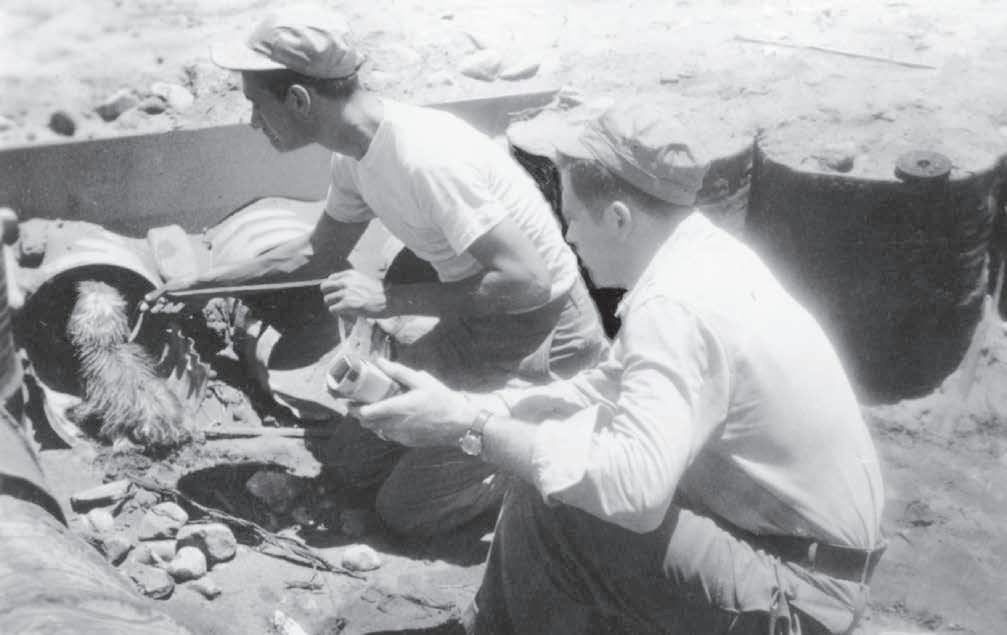
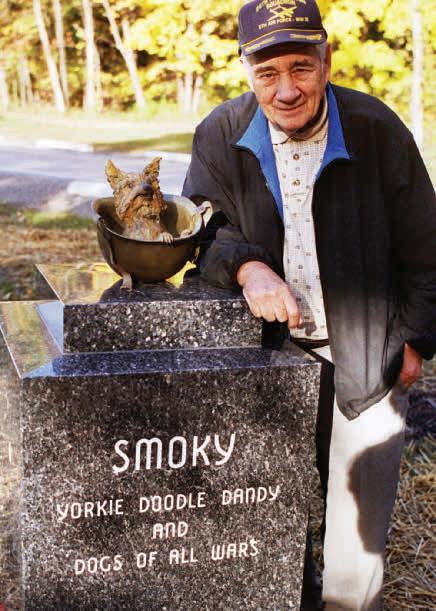
 William G. Wynne
William G. Wynne
From a Foxhole in the Pacific to Television Celebrity
SMOKY’S INCREDIBLE JOURNEY BY JERRI DONOHUE
Flat on his stomach, Cpl. William (“Bill”) Wynne peered into the 70-foot-long culvert and called to the Yorkshire terrier waiting at its other end. Smoky balked, but then gingerly advanced toward her master’s voice. Uneasiness gripped Wynne when dust obscured his view of the 4-pound dog—until she bounded from the pipe and exuberantly licked his face.
It was January 1945. A World War II draftee from Cleveland, Wynne was serving with the U.S. Fifth Air Force’s 26th Photographic Reconnaissance Squadron at Lingayen in the Philippines. To maintain essential communication with Americans at headquarters and elsewhere, his squadron needed to run a telephone line beneath the airfield. GIs risked several days of exposure to strafing by Japanese airplanes if they dug up the pipe, laid the wire and then reinstalled that section of runway.
Instead, a smart soldier had suggested Smoky navigate the pipe with string affixed to her collar. After she completed this chore, the men attached wire to the string, and within hours the culvert housed telegraph and telephone cables. Smoky’s grateful buddies gave her a steak that day, and in March 2022, the feat factored in her posthumous selection as one of the first dogs to receive the Animals in War & Peace Distinguished Service Medal. Established by House Resolution 935, the award acknowledges “the roles and contributions of United States service animals and their valiant handlers.” Bill Wynne learned of the forthcoming honor before his death in April 2021 at age 99.

SURVIVING THE WORLD WAR
Smoky entered Wynne’s life in March 1944 when one of his tent mates found the little dog stranded in a foxhole in New Guinea. Smoky’s rescuer gave her to another GI, who in turn sold her to Wynne to raise cash for a poker game. Wynne named her “Smoky” because of her gray-blue fur. A dog lover from childhood, he fed her from his rations and provided her with chlorinated drinking water. He bathed her daily in his helmet to prevent scrub typhus, a deadly tick-borne disease.
OHIOHISTORY.ORG 43
John Aiken
In civilian life, Wynne had taught tricks to another dog, and now he spent his off hours helping Smoky master simple commands. She learned to play dead, to jump through hoops and to climb a ladder. She walked a tightrope blindfolded. Wynne gradually acquired a clown costume for her and props for her growing repertoire.
Smoky’s antics endeared her to the men of the squadron, and they chose her to represent them in Yank Magazine ’s mascot contest. Wynne entered several pictures, including a shot of the tiny terrier sitting in his helmet.

Although he successfully protected his pet from tropical diseases, the Ohioan himself was stricken with dengue fever. He was recovering in the 233rd Field Hospital in Nadzab when his friends brought official notification that Yank Magazine had named Smoky “Best Mascot, Southwest Pacific Area.” Smoky visited the field hospital, too. She earned a new title, “therapy dog,” when nurses toured her through wards in the tent hospital so that she could cheer up sick and wounded GIs.
Wynne took Smoky with him on rest and recuperation leave in Brisbane, Australia, where she performed for Americans recovering from injuries in the 109th Field Hospital and the 42nd General Army Hospital.
When the two rejoined the squadron, now on the island of Biak, Wynne flew on search-and-
rescue missions as an aerial photographer. Smoky accompanied him, snoozing in his canvas musette bag. Before their military service ended, master and dog survived dozens of air raids and a typhoon. They also expanded Smoky’s act, and presented it to American servicemembers in the Philippines, on Okinawa and in Korea.
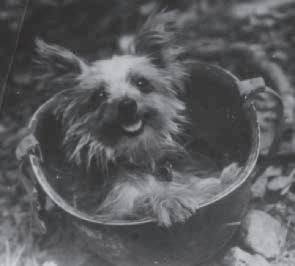
Wynne broke military regulations when he hid Smoky in an oxygen mask case, smuggled her aboard the U.S.S. General W.H. Gordon and sailed for the States and home. En route, the troop ship’s captain pardoned its numerous canine stowaways. Smoky then traveled with Wynne to Cleveland by train, arriving in November 1945.
PEACETIME ADVENTURES
The Cleveland Press ran Smoky’s story on its front page, and immediately Wynne received requests for performances. Smoky charmed patients at the Crile Veterans Hospital in Parma and children at the Parmadale orphanage. In addition to such free shows, the pair landed paid gigs at county fairs, nightclubs and other venues.
Meanwhile, Wynne married his longtime sweetheart, Margie. He spent a short time in Hollywood as a dog trainer before joining the National Advisory Committee for Aeronautics (later NASA) as a flight photographer. He eventually switched careers and won several national awards as a photographer for the Cleveland Plain Dealer.
Left: In Nadzab, New Guinea, Smoky joins Bill Wynne (left) and his fellow Clevelander, Cpl. Donald Esmond, in a song. Middle: Cpl. Wynne’s photo of his squadron’s first-class morale booster won Smoky the title of Best Mascot in Yank Magazine ’s contest. Right: Smoky poses with her “First Prize Yank Mascot” trophy. Red Cross workers in Australia sewed her uniform jacket from a card table cover, adorning it with the 5th Air Force insignia and giving the Yorkie corporal stripes.

44 Echoes | NOVEMBER & DECEMBER 2022
Howard Kalt
John
Aiken
William A. Wynne
Wynne and Smoky moonlighted in the world of show biz. They appeared on a children’s TV show as “Mr. Pokie and his dog, Smoky.” With the Yorkie as his assistant, Wynne also taught dog training on television. Smoky retired in 1954 to enjoy a fulltime role as beloved family pet to Wynne’s growing family (six children at that time), until she died in her sleep in 1957.
When the Plain Dealer published Smoky’s obituary, former Army nurse Grace Heidenreich read it and telephoned the Wynnes. Her fiancé had given her a Yorkshire terrier puppy when they were stationed in Australia, but after the Army transferred Heidenreich to New Guinea, she lost the little dog at a USO show.
Given the unlikelihood of a purebred Yorkie surfacing in a New Guinea jungle, Wynne believed his Smoky must have been Heidenreich’s missing dog. After the war, the nurse had settled in her husband’s hometown, Cleveland. For most of Smoky’s life, she had lived within blocks of her original owner.
In retirement, Wynne wrote a memoir, Yorkie Doodle Dandy, and served on the board of Yorkshire Terrier National Rescue. In a nod to our story’s happy ending, Rescue established its annual Smoky Award to acknowledge the rescues of previously lost, abandoned or abused Yorkies.
In the decades after her death, Smoky’s story spread. The Imperial War Museum in London and the National World War II Museum in New Orleans featured the pint-sized heroine in special exhibits about animals in wartime. Cleveland Metroparks dedicated a monument to her and all war dogs, and today 11 other memorials salute her throughout the United States and in Australia, New Guinea and France. Cable TV’s Animal Planet recognized her as an early therapy dog. A short film, Angel in a Foxhole, also tells her story.
During his long life, Bill Wynne adopted many dogs and cats and—after he moved to Mansfield—even a neglected horse.
But he never found another Smoky.
Jerri Donohue has written for magazines ranging from Italian America to Western New York Heritage as well as several religious publications. Bill Wynne was one of 230 World War II veterans she interviewed as a volunteer for the Library of Congress Veterans History Project.

LEARN MORE
Watch the trailer to Angel in a Foxhole at ohiohistory.org/smoky. You can stream the entire documentary for $3.95 at Vimeo.
The Futility Closet history podcast tells Smoky’s story in Episode 248, Smoky the War Dog. Listen in at ohiohistory.org/smoky2
Bill Wynne’s memoir, Yorkie Doodle Dandy, now in its seventh edition, is readily available online and can be ordered at most bookstores.
OHIOHISTORY.ORG 45
LEARN MORE
Cleveland Metroparks dedicated a monument to her and all war dogs, and today 11 other memorials salute her throughout the United States and in Australia, New Guinea and France.
I Wish I’d Been There
KU KLUX KLAN MARCH ON NILES, OHIO, NOV. 1, 1924
BY MARTHA PALLANTE
As a historian by trade, I’ve always been fascinated by certain events. One of those featured heavily in my family lore: The day the Ku Klux Klan marched on my hometown of Niles, Ohio, and was turned back by a ragtag group of immigrants and first-generation Americans.
The first time I heard the tale I must have been 9 or 10 years old. I was, as usual, at my grandma Lucia’s helping her with chores on a Saturday afternoon. I don’t remember what started the conversation about the dining room table, but she talked about when she would put all her children under the table and wait for the marchers to pass … marchers carrying crosses that they would later burn.
During the first half of the 1920s, the Youngstown-Warren area was a hotbed of Klan activity. Both Youngstown and
Niles—the latter sat directly between the larger cities of Youngstown and Warren—had elected mayors supported by the Klan.
In both places, the elected officials saw ethnic communities—Italian, Irish, Jewish—with their purported ties to extralegal enterprises such as gambling and bootlegging as easy targets. With this in mind, the Klan planned a demonstration of its power, a parade through the main streets of Niles on Nov. 1, 1924.
The Chamber of Commerce appointed a community-based committee of six to make a recommendation on the parade. After some discussion, the committee recommended 5-1 to cancel the march. The mayor, Harvey Kistler, chose to ignore the recommendation.
A BOMB ON THE MAYOR’S PORCH
As the day of the demonstration drew near, things heated up in town. Reporters and the curious poured into the city. The rhetoric on both sides grew more heated, and rumors of stockpiles of arms and ammunition circulated.
On Halloween, the night before the parade, a bomb was left on the mayor’s front porch. No one was harmed, because the mayor and his wife had decided to spend the night in Warren. Barricades were established at two points in the city, manned largely by young men of Italian and Irish descent. The governor refused pleas to send in the National Guard. Taken together, the events were like watching a slow-motion train wreck.
The final blow was a rumor circulating through the largely Catholic ethnic enclaves that the Klan planned to desecrate the sacristies of the community’s two Roman Catholic churches, Mount Carmel and St. Stephen, and to violate the nuns at the convent attached to St. Stephen.
It was a match to a powder keg. The response was electric; men and women, adolescents to the elderly, turned out in response. A human barricade circled the convent.
Children too young to participate recalled women and teenage girls “smuggling guns” in their aprons or dresses to the people mounting the defense.
A MINOR MIRACLE
Those who had thought to shelter in place and to avoid the impending violence joined the resisters in the streets anyway. The opponents appear to have been jostling each other, and one young mother recalled pulling the hood off a man approaching her and discovering her grocer underneath.
In the melee that followed, no one died, and that, in and of itself, was a minor miracle. The National Guard was finally dispatched, and the rioters were dispersed. Arrests and repercussions followed.
Ohio Gov. Vic Donahey sent Mayor Harvey Kistler this telegram declining to send in troops before the Ku Klux Klan parade. The following Tuesday would be Election Day.

46 Echoes | NOVEMBER & DECEMBER 2022
Seventy years later, my 74-yearold father was still trying to make sense of the riot. Some of his earliest memories were of sitting under that dining room table clutched in his mother’s arms, hugging his baby sister, and the images still haunted him.
He speculated that it was “fear of competition, fear of unknown, fear of … looking back at it now, I can understand that better than I did at the time … we were different than the people down the street. We were church-going people, Roman Catholic. We had customs different from them. I think they resented the fact that we were strangers in their midst.”
The questions that still nag at me are these: Who bombed the mayor’s house and why was he mysteriously spending the night in Warren? And what was the reality behind the last-minute rumors of desecration and violation?
Left: The National Guard enters Niles on Saturday afternoon to declare and enforce martial law. Right: Front page of the Nov. 29, 1924, Youngstown Vindicator.
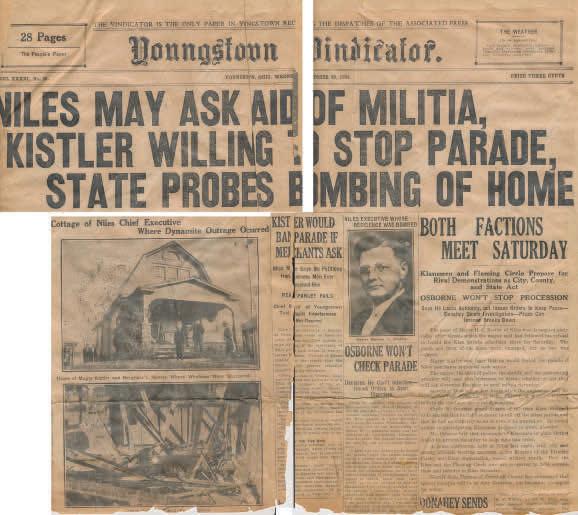
LEARN MORE
LEARN MORE
Martha Pallante is a professor of Early American History at Youngstown State University. In 2020, she was named the first Charles Darling Endowed Faculty Chair in American Social History. She is a leading expert on local history and the co-author of Italian Americans of the Greater Mahoning Valley, Youngstown State: From YoCo to YSU and Amherst, all available through Arcadia Publishing.
In an article for National Public Radio’s History Dept. website, Linton Weeks reminds readers of the 1910s and 1920s, when the Ku Klux Klan operated not in the shadows, but in the mainstream. Weeks quotes scholar Kathleen M. Blee, who says the Klan was popular enough to sponsor “in public, baseball teams, father-andson outings, beautiful baby contests, weddings, baby christenings, junior leagues, road rallies, festivals.” In his article, Weeks recommends two books Blee, a University of Pittsburgh sociologist, wrote on the subject: Inside Organized Racism: Women in the Hate Movement and Women of the Klan: Racism and Gender in the 1920s. You can read his History Dept. piece at ohiohistory.org/klan1
Joshua Rothman, Ph.D., a professor and chair of the University of Alabama history department, is the author of The Ledger and the Chain: How Domestic Slave Traders Shaped America. In 2016, he wrote a lengthy article in The Atlantic magazine with the headline, “When Bigotry Paraded Through the Streets,” which you can read at ohiohistory.org/klan2
Linda Gordon, Ph.D., the Florence Kelley Professor of History at New York University, is the author of The Second Coming of the KKK: The Ku Klux Klan of the 1920s and the American Political Tradition. The book, published in 2017, is readily available online.

All images courtesy of the Niles Historical Society
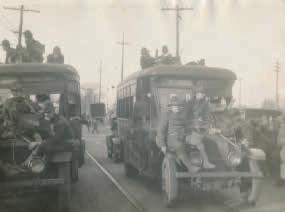
OHIOHISTORY.ORG 47
Young Eyes on the Past
BY
SULLIVAN
The United States is commonly championed as a beacon of diplomacy, as a uniter of nations and peoples and as a leader on the global stage, though the history of its interactions and diplomacy with territories, states, groups and individuals with less power or military strength paints a very different picture.
From the annexation of Hawaii to the invasion of the Philippines to, most notably, the exploitation of Native Americans, the U.S. approach to many to whom it feels superior has often been characterized by mistreatment and marginalization. The context, decision and aftermath of the 1868 Treaty of Fort Laramie display the brutality of the U.S. government in full effect.
This year’s National History Day theme was Debate & Diplomacy. Having done a project on the Plains Wars in the prior year, my familiarity with the U.S. treatment of Native nations led me to approach this topic from a different perspective.
The history of U.S. diplomacy is quite the opposite of diplomacy: essentially, it’s been a lack of diplomacy. The U.S. government has continually used its power as the dominant military and technological force to exploit those just trying to make peace with it. As it has entered negotiations, it’s used its leverage to avoid compromise and to coerce the other party to succumb to its will. When one party feels superior to another, true diplomacy can never exist.
THE TREATY OF FORT LARAMIE
When you look at the brutal result of the 1868 Treaty of Fort Laramie, you must understand the context to understand why the Native nations signed such an exploitative treaty.
On the way toward their “manifest destiny” and promises of vast wealth in the West, settlers armed with superior weapons, superior modes of communication and superior numbers of soldiers trampled through the sacred and ancestral lands of the Native Americans.
They terrorized Native settlements and individuals at the Sand Creek Massacre (and at many others), they seized Native lands as their own and they decimated the Native Americans’ most crucial source of food, the bison.
Facing a severe loss of food, land and life, it’s easy to imagine the fear of the Native Americans. Then, after all of that, the U.S. approached them with an offer of “diplomacy.”
From the beginning, this offer was never about amicable and equitable diplomacy. It was about getting the Native Americans out of the way as easily as possible. The Native Americans knew this, and yet there was nothing that they could do.
A LOPSIDED AGREEMENT
The U.S. government had created an environment where entering into a lopsided and exploitative agreement with it was the only option Native Americans felt they had. As the conference over the 1868 Treaty of Fort Laramie started, the eight white members of the U.S. government’s Indian Peace Commission were given stools and crates to sit on, and Native Americans were dismissed to the floor. Symbolically, this was an early sign for the talks to come.

Under this guise of “diplomacy,” the U.S. government coerced the Native people into signing a treaty that forced assimilation into a majority culture and way of life, confined them to small plots of land out of the way of white settlers and shipped their children away to violent and manipulative boarding schools.
Their manipulative diplomacy, intended to justify and perpetuate their exploitation, marginalization and violence toward the Native Americans, has created lasting impacts on Native Americans today. More than 150 years later, Native Americans continue to face racial and societal discrimination, and suffer mental health issues disproportionate to the population
48 Echoes | NOVEMBER & DECEMBER 2022
BROKEN PROMISES: THE 1868 TREATY OF FORT LARAMIE
MALACHY
The signing of a peace treaty by William T. Sherman and the Sioux at Fort Laramie, Wyoming, 1868.
U.S. National Archives
at large. They have struggled to preserve their culture and spiritual strength.
The World Population Review found that 33% of all Native Americans live in poverty. The impact of the treaty’s abusive education mandates continues to this day, as the school dropout rate for Native Americans is twice as large as the nation’s average.
Land thievery only continues, as corporations exploit Native American land for timber, oil and gas. And the forced assimilation first heavily perpetrated by the Treaty of Fort Laramie continues to affect and whitewash Native American culture today.
Only 175 of more than 300 Native languages continue to be spoken, and it’s predicted that only 20 will remain by 2050. In comparison to the nation’s average, Native Americans have lower income, lower levels of homeownership and less access to health care.
Diplomacy can never be achieved unless both sides approach negotiations as equals and in good faith. The racist ideologies of supremacy to the Native Americans caused diplomatic talks to spiral into a manipulative and exploitative treaty that left a lasting legacy.
Malachy Sullivan is a 2022 graduate of Columbus Academy in Gahanna and a freshman at Duke University. He’s participated in the National History Day competition for the last three years, having submitted essays and documentaries covering topics of Native American and Asian American history. Malachy loves to spend his free time playing soccer, hanging with friends and cooking. He plans to major in public policy.

The Southern Plains delegation, photographed in the White House Conservatory on March 27, 1863, five years before the signing of the Treaty of Fort Laramie. The interpreter John Simpson Smith and the agent Samuel G. Colley are standing at the left of the group; the woman standing at far right is often identified as Mary Todd Lincoln. The American Indians in the front row are, left to right: War Bonnet, Standing in the Water and Lean Bear of the Cheyennes and Yellow Wolf of the Kiowas. Yellow Wolf is wearing the Thomas Jefferson peace medal. The identities of the American Indians in the second row are unknown. Within 18 months after this photo, all four men in the front row were dead. Yellow Wolf died of pneumonia a few days after the picture was taken, War Bonnet and Standing in the Water died in the Sand Creek Massacre and Lean Bear was killed by troops from the Colorado Territory.
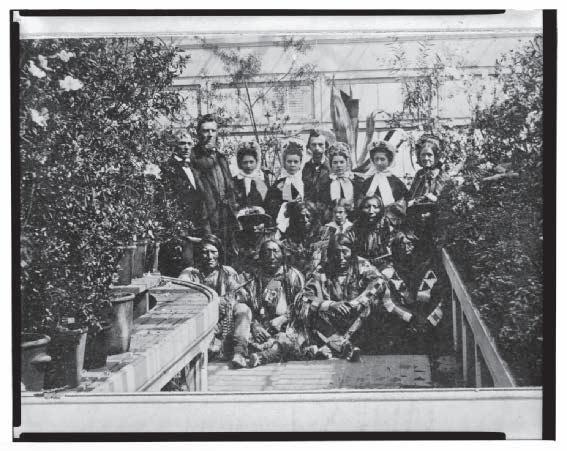
LEARN MORE
Alex Wesaw is the Ohio History Connection’s director of American Indian Relations. He recommends the following:
As Long as Grass Grows: The Indigenous Fight for Environmental Justice, from Colonization to Standing Rock by researcher and activist Dina Gilio-Whitaker “explores the fraught history of treaty violations, struggles for food and water security, and protection of sacred sites, while highlighting the important leadership of Indigenous women in this centuries-long struggle.”
In “All the Real Indians Died Off” and 20 Other Myths about Native Americans, scholars Roxanne Dunbar-Ortiz and Dina Gilio-Whitaker “tackle a wide range of myths about Native American culture
and history that have misinformed generations. Tracing how these ideas evolved, and drawing from history, the authors disrupt longheld and enduring myths” including “Indians Were Savage and Warlike,” “Europeans Brought Civilization to Backward Indians” and “The United States Did Not Have a Policy of Genocide.”
Young Eyes on the Past highlights work by Ohio students in grades 4–12 participating in regional, state and national History Day competitions organized annually by the Ohio History Connection and local sponsoring organizations statewide.
OHIOHISTORY.ORG 49
Library of Congress
Shop our Ohio History Store in person at the Ohio History Center or online at ohiohistorystore.com for this title and more.
“History exists in waves,” writes Jennifer Boresz Engelking in her most recent book, Lost Lake County, Ohio, “flowing in and out of generations through stories and passed down through heirlooms. Some stories get told again and again, while others fade over time. … But along the way, some of the details are lost, stories are forgotten and the broken pieces discarded.” Engelking concerns herself in Lost Lake County with those fading stories, those histories that’ve been broken and discarded.
In the chapter “Early Industry: 1700s–1800s,” she writes of the Waite Hill Pail Factory, which had been abandoned for several years even before the Civil War. The factory briefly reopened to manufacture washing machines before closing for good, the property becoming, as Lillie Tryon Curtis recalled nearly a century later in 1930, “the chief center of pernicious activity for the idle boys of Kirtland Flats.”
One might think that Lake County, bordered on the north by Lake Erie, would have been a bustling Great Lakes shipping center—and it was. But the county also boasted a wide array of successful businesses in the first half of the 19th century.
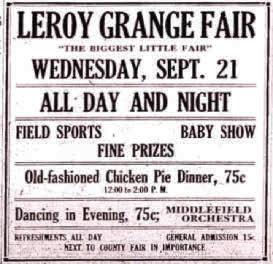
The waterfall at Paine’s Hollow dropped 23 feet and powered first a sawmill, and, according to Lori Watson of the LeRoy Heritage Association, “before long there was a gristmill, a blacksmith shop, a shoemaker, a tannery, an ashery, a wagon shop and more.”
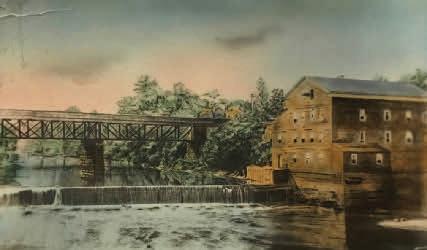
Other chapters explore the county’s “Maritime History,” its “Trains and Transportation” and its “Film, Theater and Entertainment.”
There’s a shadow of melancholy that characterizes Lost Lake County Industries have come and gone, buildings have been erected and demolished, once well-known local stories—such as the Ghost of Paine Hollow—have been all but forgotten.
And yet, writes Engelking, “The desire to preserve our past is in the very fabric of our communities. … We care about who and what went before us and know that sometimes what appears to be lost is really just waiting to be discovered.”
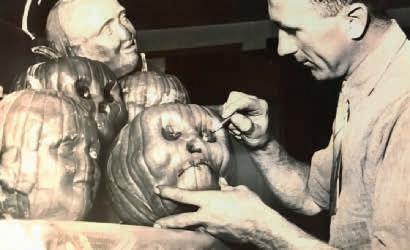 —Bill Eichenberger, Echoes Magazine
—Bill Eichenberger, Echoes Magazine
50 Echoes | NOVEMBER & DECEMBER 2022 Reviews BOOK
Lost Lake County, Ohio by Jennifer Boresz Engelking
1921 ad for the LeRoy Grange Fair at the Bates Tavern.
LeRoy Heritage Association
The old Boyce Mill in Willoughby.
John Cz creating faces on his molded pumpkins.
LeRoy Heritage Association
Willoughby Historical Society
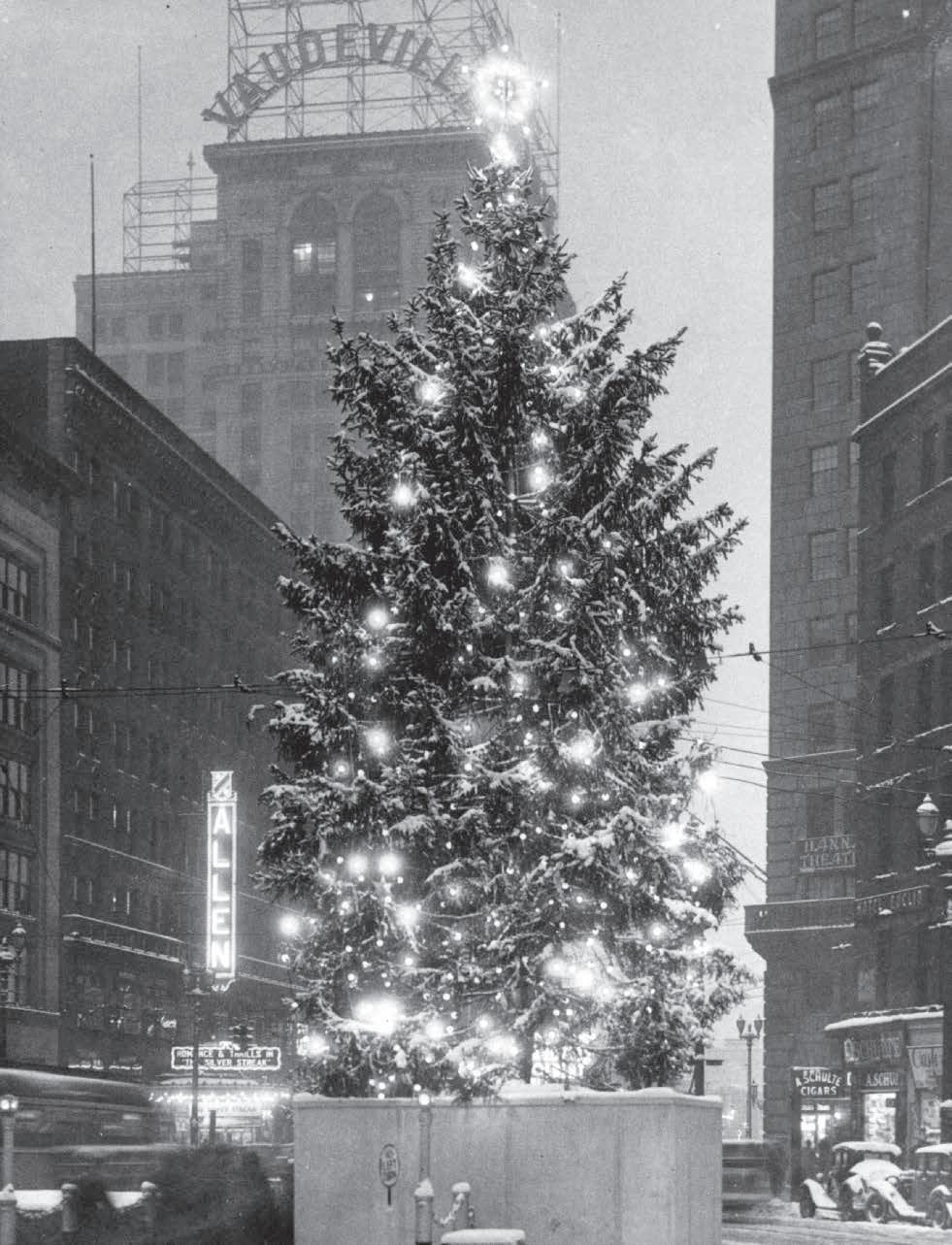 Christmas tree on Cleveland’s Playhouse Square in 1934.
Christmas tree on Cleveland’s Playhouse Square in 1934.
Cleveland Memory
NON-PROFIT













U.S. POSTAGE PAID COLUMBUS,















PERMIT No.








OHIO HISTORY CONNECTION 800 E. 17th Ave. Columbus, OH 43211-2474 ohiohistory.org ADDRESS SERVICE REQUESTED
ORG.
OH
1157 Enjoy sights and sounds of Christmas Past! OHIO VILLAGE PRESENTS Advance timed tickets required. No on-site ticket sales. Saturdays 5:30–9 p.m. • Sundays 1–5 p.m. 800.686.1541 ohiohistory.org/dickens





























































































 BY MARCI RICH
BY MARCI RICH




 Roger Mastroianni Courtesy of Playhouse Square Archives, Michael Schwartz Library Special Collections, Cleveland State University
Ohio History Connection Archival Collections
Roger Mastroianni Courtesy of Playhouse Square Archives, Michael Schwartz Library Special Collections, Cleveland State University
Ohio History Connection Archival Collections
 Restored ceiling of the lobby in the 1921 Mimi Ohio Theatre at Playhouse Square.
Photo by Kevin G. Reeves, courtesy of DLR Group
Restored ceiling of the lobby in the 1921 Mimi Ohio Theatre at Playhouse Square.
Photo by Kevin G. Reeves, courtesy of DLR Group













 William G. Wynne
William G. Wynne














 —Bill Eichenberger, Echoes Magazine
—Bill Eichenberger, Echoes Magazine
 Christmas tree on Cleveland’s Playhouse Square in 1934.
Christmas tree on Cleveland’s Playhouse Square in 1934.







